
letters
Maybe if we’re quiet, the reporter will go away
I tell journalism students going into public relations about best practices for dealing with negative information related to their company or govern ment agency: Release the information yourself, and do it early; accept responsibility; put your best foot forward, and explain mitigating factors; do what you can to shape the narrative. Be fast, honest and persistent.
Now that I’m back on the reporter’s end of the process, I see some agencies doing the opposite. They circle the wagons and hope the journalist will wander away. They drag their heels for weeks or days and then claim there isn’t enough time to find basic data, or even talk to the reporter.

Once the story is published, the pre viously silent agencies often howl that the journalist got things wrong. They shift gears from lackadaisical to very concerned when the ink is dry or the piece is posted online.
A case in point is the Nevada Depart ment of Health and Human Services’ cancer registry. Twenty years ago, in the midst of a leukemia cluster that sickened 17 children and killed three of them, I wrote about the registry’s dismal failures. The Legislature react ed; lawmakers poured money into the agency and clarified its responsibilities.
This year, I discovered the cancer registry was apparently backsliding on those reforms and now reports less information to the public than it did in 2002. I sent a query to health officials on Oct. 5 and followed up with more requests.
When deadline hit more than two weeks later, the health department had not responded to a single question. Agency staff members were too busy meeting a federal reporting deadline, they said.
Thus, there’s little information from officials in this month’s cover story. But I’ve now got another example for J-school students: When media rakes government agencies over the coals, the worst burns often are self-inflicted.
—FRANK X. MULLEN frankm@renonr.com
RIP BVD, pilot of the airwaves
Thanks for the memories. The piece on Bruce Van Dyke (RN&R, October 2022) was short, and sweet, and nice, some of the things that Bruce was typically not, if you knew him. He wasn’t short; his general demeanor and criticism was rarely sweet; and nice wasn’t a word I would have used to describe him.
He was very tall and often a little full of himself; being nice when you were a rockstar DJ would have ruined the act. We both worked in radio when Reno had about nine stations, late ’70s, early ’80s, when rock stars were tall and thin with lots of hair and screamed many of their songs. Women loved them.
I guess I kind of wanted to be him, because I was the guy down the hall who sold the radio advertising and wrote the commercial spots; I did get to go to lots of radio remotes, car dealerships, store open ings and fast-food startups. I was dressed in a duck costume … quack, quack. He had the mic and the girls.
Years later, I discovered I was not a duck, and he was not a rockstar. He was
letters@renonr.com
very bright and very nice. But never short. Bye, Bruce … see you on the other side.
Patrick Luna Reno
I still remember interviewing Bruce for a piece in the Reno Gazette-Journal about The X and its amazing resiliency. He was just so great. We talked Reno radio, The X and its birth, why the station kept coming back against incredible odds, and why so much of the station’s success was due to the pride that the people who worked there took in its existence.
Bruce said a good DJ had to take pride in being a “tunesmith” and a “wordsmith.” No one in our area was better at both than Bruce. His RN&R column, which you write about so well, Jimmy, was an extension of this wonder ful intersection of music, thought and words that Bruce inhabited so well.
I remember he called me after my story in the RGJ appeared. He thanked me for my sto ry, and said anytime I wanted to come down to the studio again and hang out, I was welcome. Come to find out, all of Reno had the same standing invitation from this uncommonly talented man.
John Trent Reno (via RenoNR.com)
He was Reno.
Iconic, a tad wacky, wonderful and totally full of the Sierra. My bucket list wish would have been to follow Bruce around in his North ern Nevada treks, to see for myself what he so beautifully described. I have collected a ton of his RN&R articles, because they were, to me, so spot on.
The news of his passing was and will always be devastating. God speed, and when you catch up with Hunter S. Thompson? I expect Tales From Beyond the Neon Babylon!
Leslie Maxwell Reno (via RenoNR.com)
Jim Marchant targets democracy

(Secretary of state candidate) Jim Marchant is spreading the Big Lie and falsehoods of rigged elections in Nevada. The former, twice-im peached president has been allowed by the GOP to spread the Big Lie while inciting an insurrection. Many courts rejected it. Who, in their right mind, doesn’t see this as an attack on American democracy? Merchant is one of those power-seeking liars!
Janet Robertson Reno
2 | RN&R | November 2022 | RenoNR.com LETTERSEDITOR'S NOTE
| November 2022 | Vol. 28, Issue 6
Email
to
Mailing address: 31855 Date Palm Drive, No. 3-263, Cathedral City, CA 92234 775-324-4440 • RenoNR.com Publisher/Executive Editor Jimmy Boegle Editor Frank X. Mullen Photo Editor David Robert Cover and Feature Design Dennis Wodzisz Contributors Wishelle Banks, Alicia Barber, Cheree Boteler, Owen Bryant, Brad Bynum, Max Cannon, Bob Grimm, Michael Grimm, Janice Hoke, Matt Jones, Matt King, Lynn Lazaro, Michael Moberly, Maggie Nichols, Steve Noel, Dan Perkins, Pax Leigh Robinson, Jessica Santina, Kingkini Sengupta, John L. Smith, Todd South, Jesse Stone, Kris Vagner, Robert Victor, Madison Wanco The Reno News & Review print edition is published every month. All contaent is ©2022 and may not be published or reprinted in any form without the written permission of the publisher. The RN&R is available free of charge throughout Northern Nevada, limited to one copy per reader. Additional copies may be purchased for $5 by calling 775-3244440. The RN&R may be distributed only authorized distributors. The RN&R is a proud member of the Association of Alternative Newsmedia, the Nevada Press Association, and the Local Independent Online News Publishers.
BY DAVID BROG
Who, living or dead, would you invite to Thanksgiving dinner? Asked in downtown Reno
Liam Kilroy Tech account manager
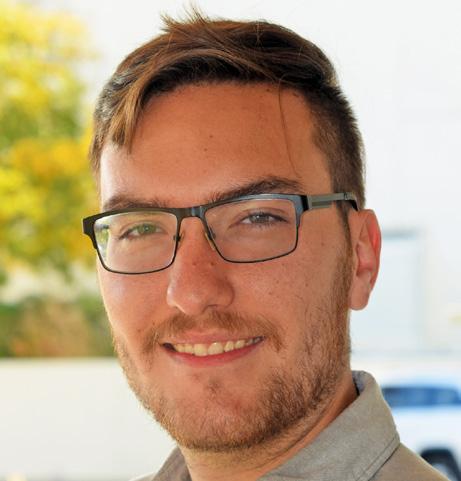

 BY DAVID ROBERT
BY DAVID ROBERT
Abe Lincoln. He proclaimed Thanksgiving as a holiday. At dinner, I’d ask him how to make politics pragmatic again. He’d probably say to be open-minded and not to be so ideologically extreme. He was a frontier lawyer and probably would prefer wild game, like pheasant, to our traditional turkey.
Serving in Congress shouldn’t be a career

One of the few things Republicans and Democrats can agree on these days is that our political system is broken. As the sound and fury of politics rises, the effectiveness of our elected officials plummets.
Congress is less popular than Genghis Kahn and root canals. We don’t have to accept this. There are concrete steps we can take to change things for the better. Term limits for Congress is the most important among these.

To understand the power of term limits, we need to go back to the American Revolution. Continental Army soldiers left farms and shops to join the fight. They then returned home seeking little more than the back pay they were owed. Their leader—Gen. George Washington—did likewise. After the war, Washington resigned his commission and returned to his farm at Mount Vernon. When he was called out of retirement to serve as president, he did so for two terms. Then he once again relinquished power and returned to Mount Vernon.
For generations, America’s leaders followed the example of Washington. But such selfless civic virtue didn’t last. Today, it’s increasingly rare for a politician to voluntarily return to private life. The citizen legislator has been replaced by the career politician—and when their primary goal is to stay in office, congressmen often prioritize two constituencies over their actual constituents back home: donors and the media. These two sources provide the paid advertising and the “earned media” that are essential to re-election.
Through term limits, we can remove the corrupting temptation of a career in Congress. The American people understand this. In our increasingly polarized country, term limits are one of the few ideas that still
enjoy broad, bipartisan support. A recent poll conducted by pollster Scott Rasmussen showed that 82% of Americans favor term limits for Congress. Broken down by party lines, 87% of Republicans favored congressional terms limits; 83% of Democrats favored term limits; and 78% of independents favored the idea.
But Congress will never vote to impose term limits on themselves. So we need to pursue another path to enact term limits. Luckily, Article V of the Constitution provides such a path. When enough states request a convention to add a term limits amendment to the Constitution, Congress is legally bound to comply. A simple majority vote of a state legislature is sufficient to make such a request.
Five states—Florida, Alabama, Missouri, West Virginia and Wisconsin—have asked for a national convention to amend the Constitution limited to the subject of congressional term limits. Nevada should be next.
For more than a century, U.S. presidents followed Washington’s example and refused to seek a third term. Then President Franklin Roosevelt ran for and won a third and fourth term. Shortly thereafter, we ratified the 22nd Amendment, limiting presidents to two terms. When presidents were no longer willing to voluntarily follow Washington’s two-term limit, we amended the Constitution to force them to do so.
The time has come to do the same for Congress. Let’s make sure that Nevada takes the lead in getting this done.
David Brog is the Nevada state chair of U.S. Term Limits, the largest grassroots term-limits advocacy group in the country. It connects term-limits supporters with their legislators and work to pass term limits at all levels of government, particularly on the U.S. Congress. Find out more at www.termlimits.org.
My grandfather, who died when I was only 1 year old. I’d like to get to know him. I’ve heard that he was a World War II vet, and there are family stories of him playing against Babe Ruth, and that he qualified for the Olympics in the 1930s. When he died, he had only two fingers left, as he had a lot of accidents in his woodshop. I would ask him if all these stories were true or family-embellished.
Jacob Nemec Warehouse team lead Sierra West Organizer
I would invite John Brown, the abolitionist. He caused an enormous slavery uprising and led a raid on Harpers Ferry, and I’m honestly thankful for the opportunity to fight today for what I believe in, and to fight for what is right. I’d ask him what he was most thankful for in his fight as an abolitionist.
Taylor Huntsman HVAC tech
My mom. She’s a traveling nurse. She moved across the country two years ago to be with her new boyfriend. I try to talk with her on the phone as much as possible, but if she came to Thanksgiving dinner, we could catch up on our lives’ events in person. We’d probably have palacsinta with our dinner. We’re Hungarian, and palacsinta is a type of crepe.
Annie Zucker Community relations

I’d invite Stevie Nicks! She’s a mysterious person and has lived a very successful life. She is also a private person. I’d ask her at dinner how her life experiences have shown through her music. I’d also ask her what her life was like on tour. I don’t know if I’d actually invite her. I wouldn’t want my vision of her to be shattered.
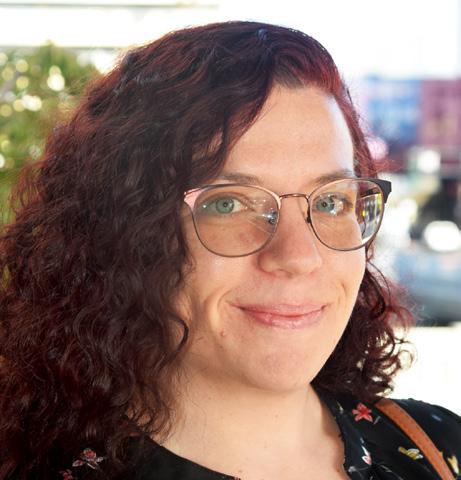
RenoNR.com | November 2022 | RN&R | 3 STREETALK
GUEST COMMENT
BY JIMMY BOEGLE
The march toward fascism continues

Florida Gov. Ron DeSantis, a likely presidential candidate in 2024, scheduled a trip to Ohio … to stump for Senate candidate J.D. Vance, and our reporters were not there because of ridiculous restrictions that DeSantis and Vance placed on anyone covering the event.

The worst of the rules was one prohibiting reporters from interviewing attendees not first approved by the organizers of the event for DeSantis and Vance. When we cover events, we talk to anyone we wish. It’s America, after all, the land of free speech. At least that’s America as it exists today. Maybe not the America that would exist under DeSantis and Vance.
Think about what they were doing here. They were staging an event to rally people to vote for Vance while instituting the kinds of policies you’d see in a fascist regime. A wannabe U.S. senator, and maybe a wannabe president.
Another over-the-top rule was one reserv
ing the right to receive copies of any video shot of the event for promotional use. That’s never OK. News agencies are independent of the po litical process.
From the Idaho Capital Sun:
A bill that would ban drag performances in all public venues will be introduced in the first days of the next session of the Idaho Legislature in January, Idaho Family Policy Center President Blaine Conzatti told the Idaho Capital Sun.
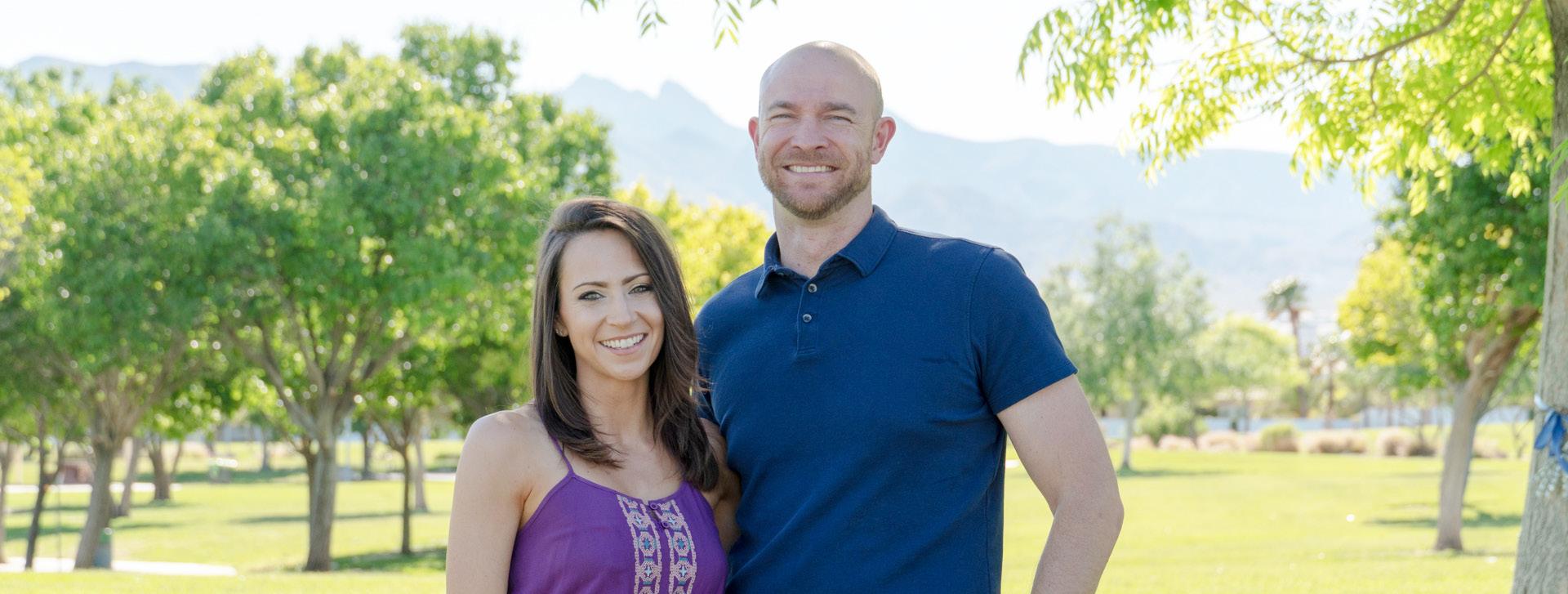
Conzatti and other conservative activists around Idaho and across the country have protested against events in public spaces that feature drag queens, including drag queen story hour events at public libraries. In September, Idaho Republican Party Chairwoman Dorothy Moon called for people to pressure corporate sponsors of Boise Pride to pull their names from sponsorship at the event over a scheduled “Drag Kids” performance for ages 11 to 18, which was ultimately postponed over safety concerns.
Conzatti said the draft bill is ready to be introduced as soon as the session gets under way but declined to share the text of the bill with the Sun and wouldn’t name the legislators
who worked on it with him.
“No child should ever be exposed to sexual exhibitions like drag shows in public places, whether that’s at a public library or a public park,” he said.
From NBC News: Congressional Republicans introduced what some are calling a national version of Florida’s Parental Rights in Education bill—or what critics have dubbed the “Don’t Say Gay” bill.
Rep. Mike Johnson of Louisiana and 32 other Republican members of Congress … introduced the Stop the Sexualization of Children Act of 2022, which would prohibit the use of federal funds “to develop, implement, facilitate, or fund any sexually-oriented program, event, or literature for children under the age of 10, and for other purposes.”
The bill defines “sexually-oriented material” as “any depiction, description, or simulation of sexual activity, any lewd or lascivious depiction or description of human genitals, or any topic involving gender identity, gender dysphoria, transgenderism, sexual orientation, or related subjects.”
From CNN: Jim Marchant, the Republican candidate for Nevada elections chief, has repeatedly promoted false conspiracy theories about elections in his closely contested state. Now, with the Nov. 8 midterms fast approaching, Marchant is going further—pushing a preposterous claim that prominent congressional Democrats in California and New York did not legitimately win re-election, though they actually won fair and square by overwhelming margins.
Marchant is one of at least 11 Republican candidates for state secretary of state in 2022 who have rejected, questioned or tried to overturn the results of the 2020 presidential election. He is the first, though, to run a campaign ad rejecting the legitimacy of the dominant victories earned by House Speaker Nancy Pelosi and Rep. Adam Schiff of California, and Senate Majority Leader Chuck Schumer and Rep. Jerry Nadler of New York.
Folks, you’ve got to get out and vote, protest, speak out and fight these attacks on freedom. In the not-too-distant future, your life may depend on it.

4 | RN&R | November 2022 | RenoNR.com
|
A NOTE FROM THE PUBLISHER
From The Plain Dealer (Cleveland) via Editor and Publisher, written by Chris Quinn, The Plain Dealer’s editor:
CONTROL TAXES. CONTROL SPENDING. CONTROL INFLATION. GET OUR STATE GOVERNMENT UNDER CONTROL! ANDY MATTHEWS FOR NEVADA CONTROLLER. As Controller, Andy will fight to ... Increase government transparency Restore fiscal responsibility Stop destructive tax hikes Combat inflation by reining in reckless spending www.AndyForNevada.com ✓ The Proven Leader We Can Trust Paid for by Andy for Nevada Andy believes the best way to end the reckless spending is to first expose it. That’s why Andy’s plan would post ALL state spending online. It’s your money – and you deserve to know what your government is doing with it. ✓ ✓ ✓


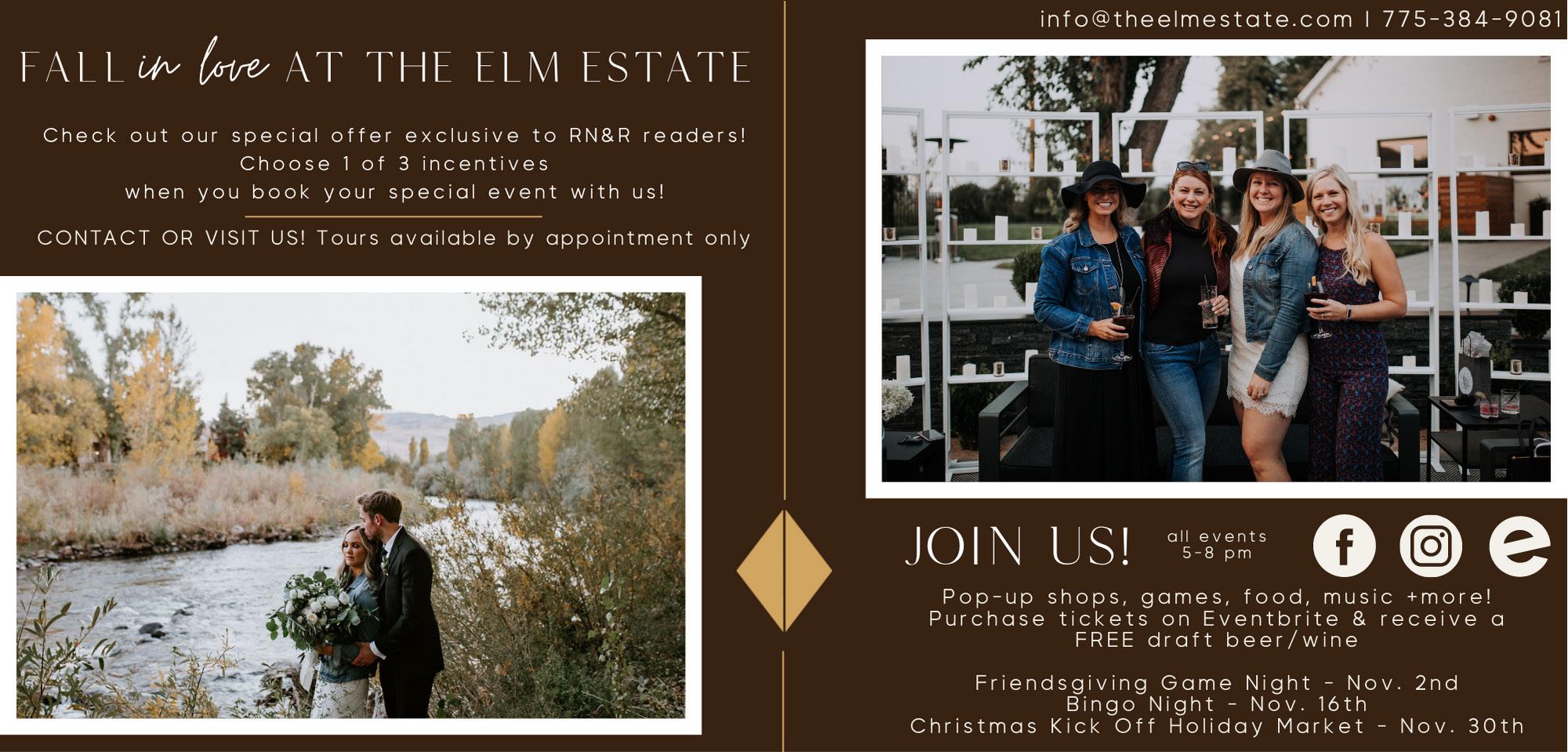
RenoNR.com | November 2022 | RN&R | 5
Paid For By Lisa Krasner For Nevada
‘Big Lie’ candidates neck and neck with opponents in recent polls
As Election Day approaches, election deniers are in dead heats with their opponents in three statewide races.
There’s no evidence of systemic fraud in the 2020 election—or any other election in the U.S. More than 60 courts have rejected claims of rigged elec tions and voter fraud, but many GOP candidates tout the unfounded allega tions. On Nov. 8, 60% of Americans will see an election denier on their ballots, according to FiveThirtyEight.com, a site that focuses on poll analysis.
In Nevada’s U.S. Senate contest, several polls released in the third week of October showed Adam Laxalt, Neva da’s top salesman for the unfounded lie that Donald Trump won the 2020 elec tion, leading incumbent Sen. Catherine Cortez Masto by one or two points, which is within the margin of error.
Polls in September put Cortez Masto ahead by 3 points in a race that is too close to call.
Jim Marchant, the Republican sec retary of state candidate who thinks Nevada hasn’t had an honest election since 2006, was leading Cisco Agui lar by two or three points in October polls. Marchant—who wants the state to return to paper ballots, and who has pledged to end mail-in voting—has consistently polled ahead of Aguilar. Marchant is arguably the most visible among a group of seven election deniers running for secretary of state offices nationwide.
In the Nevada attorney general race, an October poll showed GOP challenger Sigal Chattah, an election denier, leading Democratic incumbent Aaron Ford by three percentage points. The survey, by The Nevada Independent and OH Predictive Insights, showed Chattah with a 39-37 lead.
In the Nevada governor’s contest, the FiveThirtyEight polling averages in October consistently showed Republican Joe Lombardo about two points ahead of incumbent Democrat Steve Sisolak. Lombardo, a Trump ally, isn’t an election denier, but he has been careful to keep on good terms with the former president, who has endorsed him and recently campaigned for him in the Silver State.
—Frank X. Mullen
Horses on highways
As winter arrives, so does the ‘high strike period’ for wild equines
Suzanne Williams of southwest Reno sees wild horses on her street four or five times a week these days, but her most memorable encounter with equines happened about 15 years ago.
A friend of Williams’ son had stayed late at her house and spooked a herd of horses as he was driving home in the dark. The animals panicked, and in their haste to escape, jumped over—and on top of—the young driver’s car. He drove his trampled vehicle back to Williams’ house and called the Washoe County Sheriff’s Office to file a report.
It was a routine call for the deputy, but when the driver filed a damage claim, the insurance agent involved, who was based in the Midwest, had trouble believing a mob of mustangs had trampled the car.
“The (agent) wouldn’t believe him,” Wil liams said. “He had to send her the sheriff’s report.”
Development in South Reno has intruded on the range of the feral horses, which are man aged by the state and aren’t federally protected by the Wild and Free-Roaming Horses and Burros Act. Last year, vehicle crashes killed 19 wild horses in the area, but no humans
Tracy Wilson, Nevada state director of the American Wild Horse Campaign, said the arrival of winter will herald more crashes and horse deaths. As the rangeland dries up, the herds forage over a wider area. Photo/David Robert
died. This year, four horses have been killed in crashes to date—but that number is almost certainly about to increase.
Tracy Wilson, Nevada state director of the American Wild Horse Campaign, said the arrival of winter will herald more crashes and horse deaths. As the rangeland dries up, the herds forage over a wider area. They cross streets and highways more often than in the warmer months, so September through Decem ber is a “high strike period” for the animals, Wilson said—and due to the rapid growth in the area, there are more roads for the horses to cross, and more vehicles for them to dodge.
“This is a very fast-growing area, (with) lots of development,” Wilson said. “We’ve also added Veterans Parkway as a major northsouth thoroughfare. Not only do you have the residents of this area using the roadways, but also people using that as a way to avoid Highway 580. That was the whole purpose. All that’s great, but if you’ve ever driven Veterans Parkway through Damonte Ranch, those streets are lined with grass.”
Williams said avoiding horses during the daytime is simple, but at night, the equines don’t wear reflectors. The good news is that the American Wild Horse Campaign, state government and others have installed fencing and cattle guards at trouble spots, she said, meaning she sees fewer horses in residential areas than she did a few years ago.

“Once they opened the new highway up on the mountain, and the car traffic went way down on Old (Highway) 395, there were a lot of horses wandering around on that highway for a while,” Williams said. “Now I haven’t seen a horse out there since they put in all the cattle grates. That was a very effective thing.”
Flashing signs also have been installed on Veterans Parkway, alerting drivers at night that horses may be sharing the road. More fencing also is planned. The biggest challenge, Wilson said, isn’t fencing off the horses, but educating their human neighbors. Some people feed the wild animals, so they keep coming back—and crossing roadways to do it. In addition, some foods, including hay cubes, carrots and apples, can seriously harm the horses. Wilson noted that it’s illegal to feed the feral animals.
Marty Wright, vice president and director of Wild Horse Preservation League, has seen
6 | RN&R | November 2022 | RenoNR.com NEWS
| BY JESSE STONE
UPFRONT
horses in distress after they’ve been fed by well-meaning residents.
“One of the colts that I remember, about 6, 8 months old, got choked,” Wright said. “He’s looking around, and he can’t breathe. He’s aspirating into his lungs. They are thinking he got pneumonia because of the aspiration in his lungs. He finally got the choke out.”

Wright said helping wild horses in distress can be a dangerous task.
“You don’t just go up to a wild horse like you do a tame one,” he said.


As wild horse advocates are working to protect the animals, they also have to contend with people who tear down the fences to go off-roading in the hills.

“There are people out there who get a little upset (about the fences),” Wilson said. “That’s been a little bit of a challenge to get most people to understand that when they look up in those hills, they’re not looking at public land; they’re looking at private land. Much of it is owned by developers who have the right to develop that land as long as they meet all their
permit processes.”




This year, officials from the city of Reno, the Nevada Department of Transportation, the American Wild Horse Campaign and other nonprofit groups and agencies have collab orated to host informational sessions about the wild horse herds, and what’s being done to keep them off the asphalt. Some residents who attended the Oct. 10 presentations said they were concerned about getting access to the Virginia Range as new fencing goes up. Others worried that people moving to the area won’t be aware of the danger of running into horses—or even realize that they are about to become acquainted with herds of four-legged neighbors.
“I feel like there are two kinds of people in the area,” one resident said. “There’s those that love the horses, and those that hate them. We have driven slower; we’re more cautious; we’re more careful, because we know that they’re all around us. I wonder if people have moved into the area not knowing what they’re moving into.”
RenoNR.com | November 2022 | RN&R | 7
Flashing signs have been installed on some roads, alerting drivers at night that horses may be sharing the road.
Photo/David Robert
Digging into a massacre
Indigenous people say a lithium mine project northeast of Winnemucca will desecrate a sacred site
As a mining company waits for an archeological report regarding a site where Native Americans were massacred in 1865, tribal leaders worry about the long-term effects of the proposed lithium mine.
Work at the Thacker Pass Lithium Mine Project is scheduled to begin this fall after archeologists surveyed the area for traces of occupation by indigenous people, and evidence of the massacre. Contemporary accounts describe Nevada cavalry volunteers murdering 31 Paiute men, women and chil dren as they slept in shelters, including all the wounded people who had survived the initial onslaught. Two infants narrowly escaped execution when one of the militiamen took pity on them and took them away, according to the accounts.
Maxine Redstar, chairman of the Fort Mc Dermitt Paiute and Shoshone Tribe, said her community is awaiting the report from Far Western Anthropological Research Group, the mining company’s consultant, about the initial archaeological survey it finished this summer.
“We are cooperating with the BLM and will continue to do so, because having a seat at the table is the most important thing for our people moving forward,” Redstar said. “Of course we are concerned about what will be left for our children and those who come after
us. We are worried about the balance of how to maintain our culture and traditions, and continu ing to progress forward while making sure there is still something there in the future.”
This brief is expected to include specific findings about the cultural sites and artifacts discovered by the archaeology firm. Such surveys are required by law for all federal projects, as is consultation with tribes, to ensure that there are “no significant impacts” upon cultural artifacts on federal land.
The archeological survey is required before Lithium Nevada (a subsidiary of Lithium Amer icas Corp.) can proceed with the mine, a $1.6 billion project located about 53 miles northeast of Winnemucca. A 2018 study valued the Thack er Pass operation at $2.59 billion after taxes. Lithium is the main component for rechargeable batteries found in high-tech devices from electric cars to cell phones. It’s touted as a green-energy solution to fossil fuels, but critics say extracting the element comes at too high of a cost for rural communities, endangered species and water resources.
By law, the Bureau of Land Management is mandated to disclose any archeological findings on sites related to the native communities of Ne vada, but it isn’t required follow tribal members’ recommendations about how to treat the cultural sites or artifacts.
The Fort-McDermitt Paiute and Shoshone
A billboard on South Virginia Street offers a message in opposition to the proposed mine. Photo/David Robert

Tribe worked with Far Western Anthropology to do the survey. According to an agreement with the BLM, the firm was required to hire at least 30 members of the Fort McDermitt tribe to assist with the surveys and, at the same time, learn how to do archaeological work.
Proponents of that agreement suggested that doing archaeological work has the potential to educate young tribal professionals about the his tory of their people. That foundational knowledge would help those involved to be better advocates for their people in the future. More immediately, the program provided fair wages and training for young natives in Nevada interested in archaeolo gy, tribal members said.
The Reno-Sparks Indian Colony filed an appeal, asking the company to halt archeo logical work at the mine site. Far Western responded: “We have always put our love of gaining and sharing knowledge above money, academic credibility, or other concerns. … We acknowledge that we are studying the families and ancestors of living communities, and that the voices of these communities should be heard during this process. We continue to collaborate with Fort McDermitt, helping members of the community engage with the area’s archeological record so their voice can grow.”
While the Fort McDermitt tribe is cooperat ing with the BLM and Far Western, some tribal leaders say they don’t necessarily support of the project. Consultation with the tribe was limited; the official outreach from the mining company came during a transition in leadership—when new tribal officers were installed in December 2020, at the same time as the federal environmen tal impact statement was being finalized.
Redstar, the tribal chairwoman, described the mine as a “behemoth” that seems “unstoppable.”
Current federal regulations have minimal re quirements for consultation with tribal agencies; the main legal requirement is the sending of a certified letter. The regulations require agencies to act in good faith, but critics note that Nevada mining projects often are rushed through the ap proval process with limited input from surround ing tribes and communities.
In November 2000, the EPA released a Guide on Consultation and Collaboration With Indian Tribal Governments aimed at improving consul tation between the extraction industry and tribal agencies. The guidelines, however, are not legally binding.
The Reno-Sparks Indian colony, cited as hav ing been consulted in the environmental impact statement documents, has been embroiled in a battle of definitions with the courts in an attempt to halt the project. Its arguments center on the
meaning of “a significant cultural site” and how “consultation” is defined.
Evidence of the Thacker Pass massacre was found during the initial survey for the Ruby Pipe line in 2011. The remains of the “Indian Camp” noted in the written accounts were found on the Quinn River Valley floor, “several miles southeast of Thacker Pass on what is now private land.”
Artifacts were found during the most recent anthropological survey of native camps, but no human remains have been discovered. Archeolo gists have concluded that, due to the desiccating climate of Nevada’s deserts, human remains are rarely preserved after 150 years. The discovery of remains would automatically trigger provisions of the Native American Graves Protection and Repatriation Act, meaning work at the site would cease, albeit temporarily, while the required consultation took place.
While it’s common to find arrowheads and the obsidian flakes related to their manufacture, the discovery of more ephemeral artifacts, and of prayer sites and grave sites, are rare.
The Reno-Sparks Indian Colony suggests that the entire valley should be declared a historic site, just like some Civil War battlefields. In addition, the tribe alleged that the BLM has failed to consult all the Nevada tribes that attach religious and cultural significance to Thacker Pass. (The Thacker Pass Lithium Mine project is on land inhabited by the Northern Paiute or their ancestors for as long as 15,000 years. The tribes that consider Thacker Pass sacred also include the Shoshone-Paiute Tribes of the Duck Valley Reservation, the Lovelock Paiute Tribe, the Fal lon Paiute Shoshone Tribe and the Pyramid Lake Paiute Tribe.) Those claims have so far been dismissed by judges over the past two years.
In March, the Winnemucca Indian Colony at tempted to join the Reno-Sparks Indian Colony’s suit, but the request was rejected by the judge on the grounds that it would cost the mining compa ny millions in delays. In August, the Reno-Sparks Indian Colony filed another preliminary injunc tion while it awaits a ruling on the main case that will decide whether the BLM wrongly granted Lithium Americas’ permit for the mine.
The mining project was approved in January 2021 by the BLM in the last days of Donald Trump’s presidency. Since then, hundreds of peo ple have protested against the project, and some have camped near the proposed mine site.
Nevada’s lithium deposits were formed by a specific type of volcanic activity that is found in only a few areas of the globe. Critics say the notoriously loose environmental regulations in the U.S., coupled with the need to transport the mineral across long distances, will result in a huge large carbon footprint.
Nevada has two of the three main lithium deposits in the nation, including the McDermitt volcanic caldera, and another with a mine already in operation just south of Tonopah. The third is located in North Carolina.
8 | RN&R | November 2022 | RenoNR.com NEWS
| BY SUZANA BLEDSOE
Remembering a crusader
‘Get your ass out in the streets!’ That’s the legacy of Mylan Hawkins
In August, Nevada lost a crusader for women’s rights and abortion access who also was a health care advocate for those with diabetes.

Mylan Hawkins, 83, a prominent political and social activist, nonprofit organization leader and mentor to many budding activists, died on Aug. 26 at the age of 83. She leaves a legacy of caring for the people of our state that will echo down through generations. In my case, she affected the arc of my life.
I met Mylan in the fall of 1990 while I was a freshman at University of Nevada, Reno, and beginning to get politically active. After watching hundreds of pro-life activists form a human chain waving pro-life signs on South Virginia Street, I joined a few friends and responded in kind, showing up at the location with pro-choice signs and calling ourselves “Students for Choice.”
At the time, Mylan was running the state wide Question 7 campaign, a ballot initiative that made sure any changes to the law that guarantees abortion access can’t be made without a vote of the people. Those were heady days for reproductive rights, as the two Nevada Democratic leaders, then-Gov. Bob Miller and the late Sen. Harry Reid, held anti-abortion positions, and local abortion pro viders were being threatened with bounties on their heads and daily picketers at their clinics.
Mylan trusted me to organize several high-profile street demonstrations that attract ed media attention; she also supplied me with
pro-choice signs and talking points on the ballot initiative, which passed with more than 63 per cent of the vote. It protects reproductive freedom in Nevada to this day.
Those experiences and her mentorship laid the groundwork for my political endeavors in the years to come, which included opportunities for me to manage several local and legislative polit ical campaigns, and attend the 1996 Democratic National Convention as a delegate-at-large from Nevada.
My case wasn’t unusual. Mylan was a leader and a teacher who could harness the passion of others and empower them to make lasting changes.
Although her life was devoted to women’s rights, from running the Nevada pro-ERA campaign in the late ’70s to organizing one of the first local Reno Women’s Marches five years ago, she also was a pioneer in providing resources for those with diabetes. She co-founded, along with her late husband, Prince Ashton Hawkins, the Diabetic Educational Center to address the lack of available diabetes support services. This later grew into the Nevada and California Diabetes Association, which as of last year had saved more than $6.5 million in emergency medical supplies and helped more than 20,000 people. Mylan served as its executive director for nearly two decades and provided camps, support programs, emergency medical services, and information/ referral services.

She was always advocating on behalf of women and children’s healthcare. She founded
Project Survival, an organization that helped build a modern neonatal center at the University of Miami Jackson Memorial Hospital, and was the director of medical programs for the United Way of Dade County in Miami. While in Phila delphia she worked with former Surgeon General C. Everett Koop to raise funds for the Children’s Hospital of Philadelphia.
Later in her life, she helped found Northern Nevada Marches Forward, a nonprofit volun teer-led organization with a mission to support, spotlight and uplift the voices and power of diverse people and communities to create trans formative social change.
Mylan was honored with a proclamation by the Nevada State Legislature by State Sen. Pat Spearman on Sept. 9. The Nevada Diabetes Association recently announced the “2022 Mylan Hawkins Diabetes Community Impact Award,” which recognizes an individual who has shown dedication and distinction in shaping the future of diabetes in our community.
In January, anticipating the U.S. Supreme Court’s decision on Row v. Wade, she wrote a guest editorial in the Reno Gazette-Journal:
| BY WILLIE PUCHERT
“Without Roe, millions of women across the country will lose access to reproductive health care,” she noted. “The overwhelming majority of Nevadans support a woman’s right to choose, but we cannot take our state’s protections for granted when anti-choice extremists have made it clear they won’t stop until abortion is outlawed nationwide. … Now is the time to step up, make our voices heard, and vote.”
Mylan was like a second mother to me and a mentor to many other activists, candidates and health-care advocates. She worked right up to the end. She helped me plan a fundraising event for a progressive candidate a month before she died. Many in our community join me in feeling a deep sense of loss over Mylan’s sudden death. However, we know her legacy will live on. My lan was fond of saying: “Get your ass out in the streets!” It is our job now to take up that call.
Donations in Mylan’s name can be made to either the Nevada Diabetes Association (diabetesnv. org/donate-22) or Northern Nevada Marches Forward (northernnevadamarchesforward.org/ donate).
Willie Puchert is a local graphic designer and a former RN&R contributing writer. He has man aged and consulted on numerous campaigns for progressive candidates. He led the Students for Choice during the 1990 Question 7 pro-choice ballot referendum.
RenoNR.com | November 2022 | RN&R | 9 NEWS
Mylan Hawkins at the Reno Women's March in 2019. Photo/ David Calvert
Community spirit
The Basement at the historic post office hosts shops, art and music
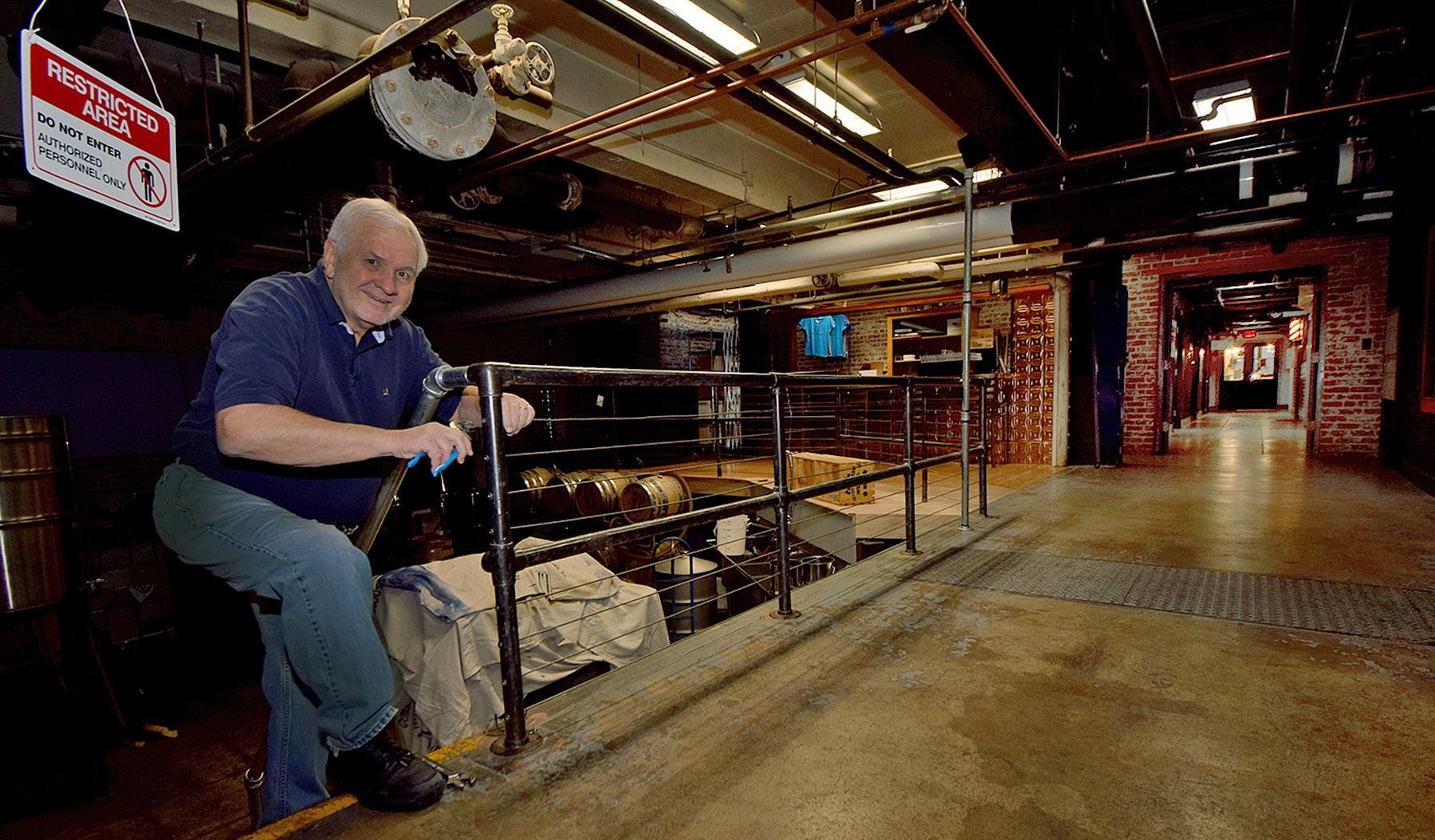
As you descend the winding stairs into The Basement of the former U.S. Post Office at 50 S. Virginia St., you feel a sense of mys tery and expectation.
Reaching the landing, you spy a commu nity of unique shops, eateries and design elements that live happily together while wrapped in the architecture of one of Reno’s landmark buildings.
“Maintenance of this building is my first objective,” said Bernie Carter, a Midtown developer who purchased the building with his two brothers and a partner in 2012. “This building means history to me. My dream is that future generations can see it.”
Carter also is focused on supporting and encouraging the 11 small businesses that inhabit the space.
“I want to support mom-and-pop small busi nesses and their dreams. They are the backbone of America,” Carter said.
The Basement, as of this writing, is fully occupied for the first time since the pandemic hit in 2020.
Carter encourages customers to shop local, rather than patronizing big retail brands. “I want this to be an economic driver for the downtown core,” he said.
To build a community spirit, Carter holds monthly meetings to inform tenants of new de velopments and marketing plans and to promote networking among the shop owners.
The Third Thursday in The Basement series of events began in September and highlights local artists on a revolving basis. The event features live entertainment, “meet the maker”
Bernie Carter, co-owner of The Basement: “This building means history to me. My dream is that future generations can see it.” Photo/David Robert
demonstrations and special sales promotions.
“We support each other,” said Jackie Lopey, a Reno native and interior designer specializing in bathroom and kitchen design. “As a sole pro prietor, you can be really lonely. I feel really safe here; my neighbors are around all the time. In this place, we support each other, refer customers to each other, and we act as a sounding board.”
Lopey has grown her Wide Canvas kitch en and bath business within the walls of the old post office. She opened her shop in The Basement’s original IRS vault when she relo cated there a few years ago. She now has five employees.
“When I moved back to Reno, I had no cli entele, no contacts,” she said. “(The Basement) has worked out so beautifully. There’s walk-in traffic that leads to business.”
Lopey strives to offer materials that shop pers won’t see in other places. She gets excited when patrons say, “I’ve never seen that before,” when viewing items such as a black faucet with contrast crosshatching. Unique wares go nicely with the historic venue, which is an asset for the tenants, she said.
A stately structure
The historic building is an asset for the tenants, she said. The old Reno Post Office, designed by Reno architect Frederic J. DeLongchamps, opened in 1934. DeLongchamps is among Nevada’s premier architects; he also designed nine county courthouses, major additions to the Nevada State Capitol, mansions for the Mapes family and George Whittell, and more than 500 other buildings. The art deco building was listed in the National Register of Historic Places in 1990.
Design features include terra cotta as a build ing material for the outer layer, which is incised to resemble quarried stone. Walls are paneled in black Georgia marble, which complements the terrazzo floors and the distinctive medallions and moldings.
Carter has commissioned exact replicas of signs and marquees in cast aluminum from artisans who practice a craft that is no longer common. Customers enjoy the stately atmo sphere, he said. When they enter The Basement, they are relaxed, curious and ready to explore, he said.
“It should be an adventure and fun to hire an interior designer,” Carter said. “The atmosphere sets a tone for my clients. People want to see and touch what’s going into their bathroom.”
Jennifer Fasullo owns Shay Co. Shop, which offers personalized gifts and clothing for babies and children. Customers she attracted online and
in pop-up events around town have come to The Basement seeking her out in her new physical location.

Her shop is popular with baby shower orga nizers and people looking for gifts for newborn babies. “There’s nothing else in Reno like it, a specific kids’ boutique,” she said. “It is the new hot spot.”
Third Thursdays events
Fasullo welcomes the Third Thursday in The Basement events from 4 to 6 p.m. At the Oct. 20 gathering, she offered a rack of special sales. At the next Third Thursday event Nov. 17, she plans to host a “meet the maker” demonstration of embroidery on clothing, baby blankets and stuffed animals.
The collaborative atmosphere resonates with Fasullo. “We all get along together, and I send customers to the coffee shop and the Replenish Refillery,” she said.
The Freshies restaurant, owned by Jake Rotchstein, is located in the common area of ta bles and chairs; store owners and their custom ers often congregate there. The menu includes fresh salads, bowls and sandwiches. Chickadee Ridge, a hot sandwich with Mediterranean fla vor, is made with roasted chicken, goat cheese, olives, arugula and tomatoes on house-baked focaccia.
“Everything is made from scratch,” Rotch stein said. The menu items are named for Sierra ski runs and locales at the area’s ski resorts.
The Basement also offers local artists wall space for art displays and sales, with no entry fees and no commissions taken. Display space is available for up to three artists at a time on a first-come, first-served basis. RN&R photo editor David Robert has an exhibition of surreal istic images on the walls this month; artist Kim Paulsen displays abstract, impressionistic works on a wall next to Freshies restaurant.
“There is no middleman; you speak directly to the artist,” Paulsen said.
Since her show has been up, she has sold a painting each week. “It’s a nice venue for an artist,” she said. “… It’s great that the building is still here, only recycled. We need to keep history alive and not allow urban decay.”
She also values the creative community of businesses and customers: “You could spend all day here just relaxing, enjoying the textures. It’s attractive visually.”

The area has lots of nearby metered parking, and the Tahoe-Pyramid Bikeway is accessible on the north side of the building. The facility is dog-friendly.
Brooke Brumfield of Fior Partners, who frequently commutes from Verdi to Reno on her bicycle, sees The Basement as “the living room of downtown.
“It’s comfortable and warm, a great place to come after work for a snack or drink and a look around,” she said.
10 | RN&R | November 2022 | RenoNR.com NEWS
| BY JANICE HOKE
CRYSTALS + PLANTS + LOCAL JEWELRY 224 Vassar Street, Reno @crystalplazareno MENTION THIS AD FOR A DISCOUNT!
Planets
November skies
This month brings an Election Day total lunar eclipse, Mars sightings in both mornings and evenings, and much more
November’s evening sky chart. Illustration/Robert D. Miller
3.7-magnitude Gamma Cap is 1 3/4° west of Delta. With careful attention over several days near the year’s end, you can detect the slow motion of Saturn against these stars.
Mornings: Mars brightens from magnitude -1.2 to -1.8 in November, in the west to west-northwest, dropping lower as the month progresses. Mars appears at opposition on the night of Dec. 7, when it’s up all night— low in the east-northeast at dusk, high in the south in the middle of the night, and low in west-northwest at dawn. Thereafter, it can be followed in the early evening sky. Mars retrogrades (moves west) 5.5° in November, passing directly between stars of Taurus— second-magnitude Beta and third-magnitude Zeta—on the morning of Nov. 13. On Nov. 19-23, Mars passes within 4° south of Beta, tip of the northern horn.
The twinkling blue-white Dog Star, Sirius, in the southwest at magnitude -1.4, is the brightest point of light in November’s morning sky until steady, reddish Mars outshines it starting in the second week. Mars’ brightening is caused partly by its decreasing distance, from 57.4 million miles on the morning of Nov. 1, to closest approach at 50.6 million miles on the evening of the 30th. The other factor increasing the planet’s brightness is the phase effect, or opposition surge, with Mars’ phase changing from 94 percent on Nov. 1 to 100 percent full on Dec. 7, when the red planet will be at opposition, as Earth passes between Mars and the sun.
| BY ROBERT VICTOR
21. The last old crescent moon, 3 percent full, can be spotted very low in the east-southeast in morning mid-twilight on Nov. 22.
On Oct. 30, Mars commences 74 days of retrograde (westward) motion, ending Jan. 12, 2023. Mars begins retrograde 2.7° northnortheast of Zeta. Mars will peak at magnitude -1.9 between its closest approach to Earth on Nov. 30 and its opposition and all-night visibility on Dec. 7.
Through the telescope: In the evenings, Jupiter’s cloud belts and changing positions of the four bright satellites are fascinating to watch. Saturn’s rings are gradually closing; they’re tipped 15° from edgewise on Nov. 19, to 14° on Dec. 22, and 13° on Jan. 14—so look soon for your best view of the rings until Spring 2028.
In November and December 2022, the bright northern limb of Mars is primarily the NPH, or North Polar Hood (cloud cover overlying the north polar region), and not the North Polar Cap (NPC), consisting of ices of water and carbon dioxide on the Martian surface. Mars’ northern spring equinox will occur on Dec. 26, and in the following weeks, the NPH will dissipate and reveal the NPC. Get those scopes out, and start looking for Mars’ surface features, although Martian dust storms might diminish our view.
Mars brightens in November to become the No. 1 morning “star.” In the evenings, Mars rises earlier, joining the two other bright outer planets, and ranks No. 2, after only Jupiter
Oh, and don’t miss the total lunar eclipse in the predawn hours of Election Day!
Evenings: Brilliant Jupiter, magnitude -2.8 to -2.6, and Saturn, magnitude +0.6 to +0.8, adorn the east-southeast to southern sky at dusk. Saturn is 41° to 39° west of Jupiter this month. The waxing moon appears near Saturn on Nov. 1 and 28, and near Jupiter three nights later, on Nov. 4 and Dec. 1. Use binoculars just before sunset on Nov. 4 and Dec. 1 to try to score a daytime sighting of Jupiter near the moon. Ranking in brightness next after Jupiter in November’s early-evening sky are
golden Arcturus, sinking in the west to westnorthwest; and blue-white Vega, overhead to very high in the west-northwest. Mars far outshines these stars, but at the start of November, it rises, far north of east, not until about 2 1/2 hours after sunset. A waning gibbous moon closes in on Mars from the evening of Nov. 10 until dawn on Nov. 11.
Mars rises a few minutes earlier each evening, and by the last days of November, Mars rises before mid-twilight and appears on our evening twilight map.
On Nov. 1, Saturn is within 0.7° to the eastnortheast of the 4.3-magnitude star Iota in Capricornus. Saturn ended retrograde on Oct. 22, and has begun a slow return toward Delta Cap, or Deneb Algedi, the 2.9-magnitude star marking the end of the tail of the Seagoat, 5.3° to Saturn’s east on Nov. 1. Fainter
After the total lunar eclipse in the predawn hours of Tuesday, Nov. 8 (more about the eclipse below), the waning moon passes through Taurus, Nov. 9-11. Look about an hour before sunrise, before twilight brightens much, to catch the moon 3 to 4° south of the Pleiades cluster on Nov. 9; 7 to 8° north of Aldebaran, eye of the Bull, on Nov. 10; and 2 to 3° north of Mars on Nov. 11. Follow the moon and Mars until sunrise on the latter morning, and you’ll have a good chance to attain a daytime sighting of Mars, with binoculars if not the unaided eye.
Continuing eastward through the zodiac, the moon forms an isosceles triangle with the “twin” stars, Pollux and Castor in Gemini, 6-7° from each, on Nov. 13. The twin stars are 4.5° apart. On Nov. 16 (last quarter moon, half full) and 17 (a fat crescent), the moon appears 7 to 8° from Regulus, heart of Leo the Lion. Spaceship Earth is heading directly toward Regulus on Nov. 22. A thin crescent moon, 8 percent full with earthshine illuminating its dark side, appears 5° to the lower left of Spica on Nov.
There will be a total lunar eclipse in the predawn hours of Tuesday, Election Day, Nov. 8. (Don’t forget to vote!) From the Western U.S., the partial phase gets under way at 1:09 a.m., and the 86-minute total eclipse begins at 2:16 a.m. The deepest and likely the darkest stage of the eclipse, when the moon is closest to the center of Earth’s shadow, occurs at 2:59 a.m. At that time, in clockwise order, starting with the star Pi in Aries, the eclipsed moon will be closely surrounded by three stars and Uranus: Pi to upper right of the moon, then Omicron, and Sigma in Aries, and Uranus, to the moon’s upper left. The moon starts to emerge from totality at 3:42 a.m., and is completely out of the umbra at 4:49 a.m., when only some slight penumbral shading will be noticed.
The entire encounter of the moon with the umbra, or dark core of Earth’s shadow, lasts 3 hours and 40 minutes, so if you want to view the most beautiful and colorful stage of the eclipse, try 2-2:30 a.m., or 3:30-4 a.m.
Sky Calendar includes illustrations of many of the events described in this article. To subscribe or to view a sample issue, visit www. abramsplanetarium.org/skycalendar.
Robert Victor originated the Abrams Planetarium monthly Sky Calendar in October 1968, and still produces issues occasionally, including December 2022. He enjoys being outdoors sharing the wonders of the night sky.
RenoNR.com | November 2022 | RN&R | 11 ASTRONOMY
and Bright Stars in Evening Mid-Twilight For November, 2022 This sky chart is drawn for latitude 40 degrees north, but may be used in continental U.S. and southern Canada. Stereographic Projection Map
by Robert D.
Miller Evening mid-twilight occurs when Sun is 9 below horizon. Nov.1: 44 minutes after sunset. 15: 45 " " " 30: 47 " " " N S E W 29 Mars 1 8 15 22 29 Jupiter 1 8 15 22 29 Saturn Aldebaran Capella Arcturus Antares Vega Altair Deneb Fomalhaut
Critters on the move
The changing of the seasons means changes in the habits of Reno-Tahoe’s wildlife
It’s leaf-peeping season! Not only are the colors of the trees and plants changing as they prepare for winter; animals are on the move as well—and the Reno-Tahoe area is full of great spots to check out fall animal behaviors, if you know where to look.
In the mountains around Tahoe, bears are packing on their last pounds before hibernating for at least part of the winter. Though many Tahoe bears wake up for some easy trash-foraging, they still bulk up for long periods of sleep. You can often spot them along Taylor Creek on the south shore of Lake Tahoe, fishing for the salmon swimming upstream.
Speaking of salmon, the Kokanee salmon head from Lake Tahoe up Taylor Creek to spawn. These non-native fish have found a happy home in Lake Tahoe after being introduced many years ago.
Thousands of them swim up Taylor Creek, next to the Taylor Creek Visitor Center, every fall to spawn in the rocky stream bed and then die. Before they do so, these large fish turn bright red, making them easy to spot in the shallow waters.
Many of the birds that live around Lake
Tahoe in the summertime head to warmer climates as the weather cools. Though some bright-colored species like the Western tanager and Calliope hummingbird head south, many more stick around—and change their habits. As summer’s bounty becomes more scarce, Steller’s jays often resort to stalking other cache-making birds in an attempt to steal their food.
Mountain chickadees stop making their iconic “cheeseburger” call—which is a territorial call they utilize to claim space during breeding season—but stay in the area. Large flocks of them live around Chickadee Ridge, just south of Mount Rose and Mount Rose Meadows, above Incline Village. You can hike (or snowshoe) out to the area year-round to visit these classic Tahoe residents.
Bald eagles also stick around all year, simply changing the types of birds they’ll catch, and relying on fish to get them through the winter. Fall and winter are great times to spot these illustrious birds along Tahoe’s shores, as many of their raptor competitors (like ospreys and turkey vultures) migrate south, giving them more space to roam.
The Tahoe Institute for Natural Science (tinsweb.org) hosts two major winter-bird
BY MAGGIE NICHOLS


Some of the birds that live around Lake Tahoe in the summertime head to warmer climates as the weather cools, while many more stick around—and change their habits.
 Photo/Maggie Nichols
Photo/Maggie Nichols
surveys you can join, which contribute to citizen science across the country—the MidWinter Bald Eagle Count and the Christmas Bird Count.


Dozens of species of waterfowl migrate from and through Tahoe on their way south. Spooner Lake is a favorite stopping point for many—and an excellent place to appreciate fall in the mountains. A flat, 2-mile-long-trail circumnavigates this small alpine lake, running through changing aspen trees and offering ample bird-viewing opportunities. At various points through the fall, you may spot whitetailed kites, canvasbacks and mergansers.
Migrating birds are seemingly everywhere you look. The valleys containing and surrounding Reno to the north and south become a safe haven for many species. Geese are some of the most obvious migrators, making noisy flocks in meadows, wetlands and grassy urban fields during the day, and honking their way overhead at night. Tundra swans can occasionally be spotted joining these mixedspecies flocks.
Our warmer, lower-elevation valleys provide overwintering havens for many diurnal raptors.
From Gardnerville to Susanville, Cooper’s hawks, northern harriers and prairie falcons can regularly be seen hunting for prey along roads and in fields. Golden eagles come down from the mountains and join other residents like rough-legged hawks, soaring over ditches and open spaces. Even ferruginous hawks can be counted among our visitors during cooler months. And, of course, red-tailed hawks and American kestrels are still regular post and powerline sitters, searching for their next meal.
Mule deer are often about, as they make their way down the mountains to warmer weather for the winter. Even the wild horses change their behavior a bit, tending to hang out in larger groups and closer to water during the colder seasons. Washoe Lake State Park is a great place to spot big herds in the winter.
Make a whole day out of watching nature prepare for winter by heading out of town to Lahontan State Recreation Area or the Stillwater National Wildlife Refuge. Don’t have that much time? Hidden Valley is crisscrossed by wetland wildlife-viewing trails you can walk along or stop to watch.
The entire Truckee River corridor is full of critters as well. Mornings and evenings are prime times to glimpse animals moving about to find their foraging grounds for the day. Get there early, and pack a chair and blanket—and maybe your favorite hot beverage or a journal!
12 | RN&R | November 2022 | RenoNR.com HIKING
|
The last one showering shouldn’t be left in the cold! GO TANKLESS. FREE Quotes Tank Options & Tankless Think Free!
When 16 children were diagnosed with leukemia in Fallon 20 years ago, and three died, federal and state investigations failed to pinpoint a cause—but officials said the lessons learned in that outbreak would help the Nevada Department of Health and Human Services detect and respond to future cancer clusters.
Yet despite reforms mandated by the Nevada Legislature in 2003, Nevada health officials today report less cancer-tracking information to the public than they did in 2002. The state’s cancer registry is now a shadow of what it was after lawmakers expanded its budget and clarified its responsibilities.
As a result, the Silver State is apparently even less prepared to deal with a cancer outbreak now than when health officials were caught flat-footed by the Fallon leukemia cluster the early 2000s.
“You want to believe our system works, that we learn from the past, and that (agencies) will try and do better, try to fix the situation,” said Richard Jernee, whose son, Adam, 10, was the first Fallon leukemia cluster patient to die in 2001.
“But it was all just words. I don’t believe (health officials) had any real intention of doing anything.”

NO ANSWERS FROM THE STATE
Nevada Department of Health and Human Services officials declined to answer questions about the state’s cancer registry from the Reno News & Review, despite being notified of this story more than two weeks before the RN&R’s deadline.
The newspaper first queried the health department on Oct. 5, and officials said they would work on the request. A week later, they requested written questions. On Oct. 21, the story’s deadline, a department spokesperson
told the RN&R that the newspaper’s queries “would require extensive research and staff time.” The registry, she wrote, was unable to respond due to a looming federal deadline for the submission of statewide cancer data to the National Program of Cancer Registries.
That program’s website shows Nevada as the only state without data available in 2019 (the latest year available). Although a 2003 law mandated that the state report cancer-incidence data to the public, the registry hasn’t published a report since 2015. In 2001, the registry launched a public website that allowed anyone to check cancer incidences in each of Nevada’s 17 counties. That site no longer exists; officials declined to say when it was deleted and why.
Jernee, other family members of cancer patients, health-care advocates and researchers who had been involved in the Fallon investigations two decades ago were dismayed
that the state apparently failed to follow through with the reforms. But they weren’t shocked.
“I’m not surprised (Nevada officials) backpedaled,” Jernee said. “They serve themselves more than anything else. … The health department was a mess in 2002, and it’s a mess now.”
A BOY WHO LIKED THE BEATLES
Richard’s son Adam loved listening to his dad’s classic rock albums—the Beatles and Journey in particular—and playing with Legos. He had a quirky sense of humor and dreamed of being a comedian.
He was diagnosed with acute lymphocytic leukemia (ALL) in late 1999, the third patient in a cluster that eventually included 16 children. His treatment included two rounds of chemotherapy, two bone marrow transplants and radiation. He was in remission from the cancer within a year, but the radiation damaged his lungs, and he died on June 3, 2001.
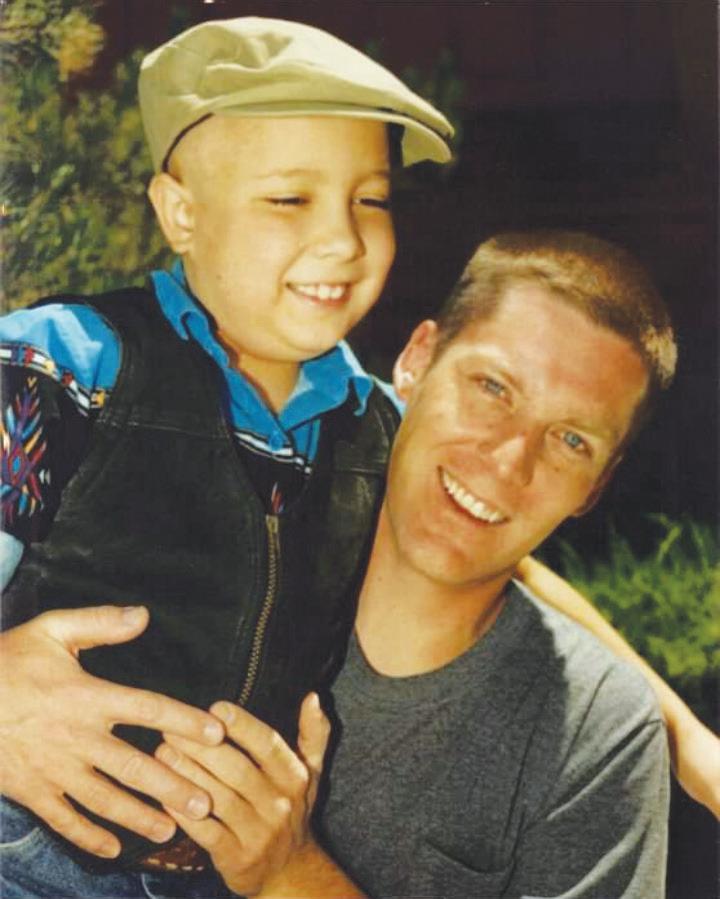
“He beat the cancer, but the treatment killed him,” Richard Jernee said. “I’ve moved on, but every so often, the whole Fallon experience comes back and bites me. It never goes away.
… We never got answers. People deserve answers.”
The first child in the Fallon cluster was diagnosed in 1997. Adam and a 3-year-old boy were diagnosed with ALL in 1999, and six more Fallon children were diagnosed in 2000. That year, a nurse at Fallon Community Hospital became alarmed at the spike in cases and called state officials. By July 2002, more cases surfaced; the state “closed” the official cluster at 16 children.
At the point when 11 cases had been diagnosed, scientists calculated the odds of the cluster being coincidental at 232 million to one. Their paper noted that “a cluster of this magnitude would be expected to occur in the U.S. by chance about once every 22,000 years.”
Nonetheless, a top state health official at the time said it could still be random: “Somebody has to win the lottery,” he said.
The patients’ parents didn’t think God was playing dice with the lives of their children. They lobbied for a federal probe and found a passionate ally in the late Sen. Harry Reid, who supported a Centers for Disease Control and Prevention investigation and later secured
RenoNR.com | November 2022 | RN&R | 13
“ You want to believe our system works, that we learn from the past, and that (agencies) will try and do better, try to fix the situation. But it was all just words. I don’t believe they had any real intention of doing anything. ”
— Richard Jernee, whose son, Adam, died in 2001
continued on next page
Richard Jernee, with his son, Adam, who was the first Fallon leukemia cluster patient to die, in 2001.
federal funding for further research. Some of the parents also testified at the Legislature, asking for the state to more effectively track cancer outbreaks, and to analyze cancer case data to spot trends.
In 2001, state health officials said the state’s cancer registry on its own would not have detected the outbreak for years—if ever. The agency had been on a downward slide for a decade. In 1989, national health officials praised the Silver State’s registry as a national model. But 10 years later, the registry consistently failed to meet national standards and reported less cancer incidence information, less frequently, than it did a decade earlier. The state collected data, but didn’t analyze it. In 1993, doctors and a hospital representative told an Assembly committee that the registry had become useless.
Officials blamed tight state budgets for the registry’s decline, but said they wanted to make the registry an efficient public health tool. The 2003 Legislature amended the registry law and clarified its responsibilities for analyzing data. The late Sen. Joe Neal— the reform bill’s sponsor, who also backed cancer-tracking bills in 1983—said the registry wasn’t following the intent of the law. Neal, along with the late Assemblywoman Marcia de Braga, spearheaded the 2003 law changes. Those amendments required the registry to look for trends in cancer cases and to investigate possible outbreaks—the things it was initially created to do.
Between 1990 and 2001, the registry’s budget, the bulk of which comes from federal grants, ballooned from $66,000 to $417,000. The annual allocation doubled in the years following the 2003 law change—but was cut in half by 2020. Its budget topped out at $1.1 million in 2009, but by 2020, the registry’s
allocation was down to $680,790.
The state-funded portion of the registry’s budget was increased in 2021, when lawmakers passed a bill to tax certain medical equipment to provide more funding for the agency. The increase was touted as allowing the agency to hire more two staff members to help it reach “full compliance with reporting standards.”
In 2023, the registry’s budget will be $1.2 million, according to legislative records. It’s unclear whether the funding increase will help restore the registry’s lost functions.
FEDERAL INVESTIGATION ‘INCONCLUSIVE’
On the CDC’s current map of national cancer statistics, Nevada is the only blank spot, because the Silver State “did not meet (federal) publication criteria.” The 2003 law requires the registry to investigate any unexpected cancer trends, but it’s unclear whether any such investigations occurred.

Those topics were among the queries that state officials said they had no time to answer.
During the Fallon leukemia outbreak, the state health department was the initial agency investigating the cluster. At the time, the families of the leukemia patients were frustrated with the slow pace of the state’s response.

After the surge in Fallon cases was confirmed, state officials spent about a year developing a questionnaire to be given to patient families, and a control group. No common environmental exposures were flagged that might explain the spike in cases.
About 1,000 suspected cancer clusters are reported to state health departments each year, according to the American Cancer Society. From 1961 to 1982, the CDC investigated 108 reported cancer clusters, but no clear cause was determined for any of them. After federal officials declared the Fallon outbreak as the “most significant and verifiable” childhood cancer cluster on record, the CDC launched an investigation that was more costly and extensive than any it had done before.
The late Floyd Sands, whose daughter, Stephanie, was the second
patient in the cluster to die, had high hopes for the probe, which employed new technology to assay tiny traces of elements in human bloodstreams. But Sands and other parents of leukemia patients were soon disappointed.
Health investigators collected air, water and soil samples from the patients’ properties—but those samples were collected at the homes where the children lived at the time of the investigation, rather than the places they lived when they were diagnosed. Another federal agency collected statements from local industries, relying on selfreporting rather than independent research.
When parents complained that the methodology seemed illogical, the federal and state investigators were often condescending. “We have protocols,” parents were told. “You just don’t understand science.”
The Fallon community mobilized to help the families affected, but there also was a backlash against the publicity surrounding the cluster. A TV show dubbed Fallon “Cancer Town, USA”; a documentary about the cluster was initially titled Deadly Oasis; and 60 Minutes reported on the cluster. Fallon home prices sagged, and properties listed for sale languished on the market. Some residents—and businesses— moved out of town.
In 2003, the CDC declared its investigation inconclusive. The only anomaly found was unusually high levels of the element tungsten in both the bodies of the patient families and the control group.
SOME RESEARCHERS GOT RESULTS
While the state and CDC were conducting their tests, some of the patient families and independent investigators took action. Floyd Sands in 2002 organized a door-to-door cancer survey in Fallon, which uncovered other possible outbreaks, including a suspected cluster of brain cancer.
State health officials rejected Sands’ findings as unscientific, but other experts told the Reno Gazette-Journal at the time that even though Sands’ survey didn’t follow standard protocols, the results were compelling and warranted more investigation.
That never happened.
Two Arizona researchers got involved at the request of some of the families. Dr. Mark Witten, then a professor of pediatrics at Arizona State University, exposed lab rats to jet fuel, a suspected cause of the outbreak, but soon ruled it out. His colleague, Dr. Paul Sheppard, analyzed the traces of chemicals in tree rings and found high levels of tungsten and cobalt in the trees around the town.
Witten’s experiments indicated that those two elements could alter the genes in lab rats. Those findings were replicated, Witten said. In addition, Witten found evidence of a viral outbreak in Fallon prior to the leukemia cases surfacing— something that also happened in Sierra Vista, Ariz. That town, which also has high tungsten levels, weathered a childhood leukemia cluster at the same time as Fallon.
“Basically, we have it solved,” Witten said. “In both Fallon and Sierra Vista, we have a virus and tungsten. I believe it’s a double-hit.” He said the combination of the virus, along with chronic exposure to tungsten, could explain both outbreaks.
Sheppard, who pioneered the use of treering cores to track environmental pollutants, also uses other data types in his research, including soil, inhalable dust and lichens and mosses. Other scientists have since embraced his techniques, which have been used to track environmental pollutants in Chile and investigate a childhood cancer cluster in Clyde, Ohio.
Sheppard said cancer registries need to do a better job of detecting outbreaks.
“We can’t depend on the system we had then and still have now: a bunch of mothers from the same community running into each other in an oncologist’s office,” he said. “We can’t depend on a system where the case data is two or three years old.”
He noted that cancer reports come into registries as they are diagnosed, but the agencies take years to verify the data. When an unexpected number of cases comes in
14 | RN&R | November 2022 | RenoNR.com
“ We can’t depend on the system we had then and still have now: a bunch of mothers from the same community running into each other in an oncologist’s office. We can’t depend on a system where the case data is two or three years old.”
— Dr. Paul Sheppard, who uses tree rings to detect pollutants over time
On the CDC’s current map of national cancer statistics, Nevada is the only blank spot, because the Silver State “did not meet (federal) publication criteria.” continued from Page 13
from a given area, he said, there should be a way registries can flag that spike in real time. “Amazon and other companies instantly update customers’ information,” he noted. “We have the technology, but it’s not being used.”
For the last 20 years, Witten and Sheppard have continued to investigate cancer clusters all over the country. They also are helping the Trevor’s Trek Foundation, which was founded by Charlie Smith, the mother of a brain-cancer patient. Smith spearheaded Trevor’s Law, passed in 2016, which requires the CDC to regularly revamp its guidelines for cancercluster investigations.

That process also is moving at a glacial pace. The CDC began updating the guidelines through 2018, and solicited public comment on the changes the following year. So far, Congress has allocated $4.5 million for the effort.
Trevor Schaefer, the law’s namesake, was 13 in 2002 when he was diagnosed with brain cancer, one of five such cases diagnosed in his small Idaho town that year. Health officials told his mother that the town was “too small to have a cancer cluster” and that so many cases were just bad luck. Those attitudes sent Smith on the path to improve the way cancer clusters are tracked and investigated.
Now 32, Schaefer is cancer-free and is the executive director of the Trevor’s Trek Foundation. He said all over the country, patients’ parents have the same story.
“When residents are concerned about unexpected high numbers of cancer in their communities, they get the run-around from health officials,” he said. “They juggle the numbers and say there’s nothing wrong, or that the population is too small for the numbers to
be significant.”
Schaefer said community members worry about the economic impacts of being branded with a cancer cluster, and health agencies often deny there’s a problem, or they slow-walk investigations.
“It seems that a lot of people don’t care (about cancer outbreaks) unless they are affected personally,” Schaefer said. “It’s hard to change people’s mindsets. Agencies need to be held accountable. ... Cancer patients are not just numbers in a report. Investigating clusters is not an academic exercise.”
The CDC is expected to publish new cancercluster guidelines next year, and Schaefer remains optimistic.
“We’ll get it done,” he said. “The law is just the beginning.”
Witten, who, with Sheppard, is currently investigating a cancer cluster on the East Coast, isn’t so sure agencies will ever do what is necessary to track clusters and dig deep to find environmental causes.
“But we’re not giving up,” Witten said. “There’s too much work to do.”
Richard Jernee, meanwhile, said his grief over Adam’s death is compounded by the knowledge that in the 20 years since cancer changed so many lives in Fallon, many other communities have weathered cancer clusters.
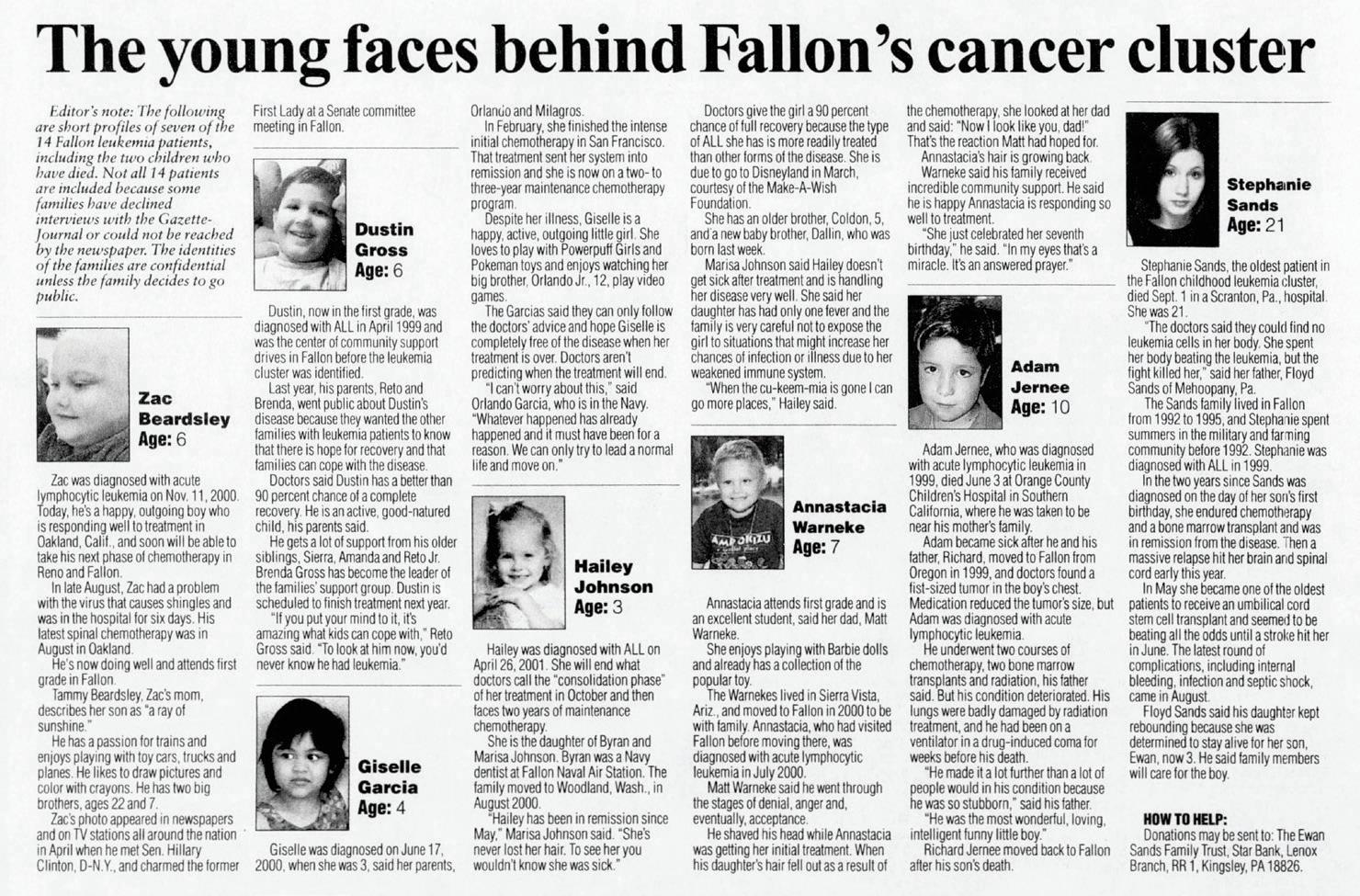
“It isn’t bad luck when so many kids get sick in a small area,” Jernee said. “Something is responsible for it. People need answers. The Fallon families still need answers.”

RenoNR.com | November 2022 | RN&R | 15
A Reno Punk Rock Flea Production
RN&R editor Frank X. Mullen wrote more than 70 stories about the Fallon cancer cluster between 2000 and 2011 while a reporter for the Reno Gazette-Journal
A page from the Sept. 30, 2001, Reno Gazette Journal with profiles of seven patients from the cancer cluster.
Our authentic voice
The Poetry Project asks Nevadans to pen poetic ‘letters’ inspired by the Silver State
From the vast sagebrush ocean to the majesty of the Sierra, the Silver State is a poem waiting to be written—again and again and again.
That’s why the Nevada Arts Council and Poet Laureate Gailmarie Pahmeier are inviting Neva dans to submit poems for Nevadan to Nevadan: What I Need to Tell You, the Nevada Poetry Project. Don’t panic; it’s as easy as writing a letter. (Remember those? They are like emails, but better.)
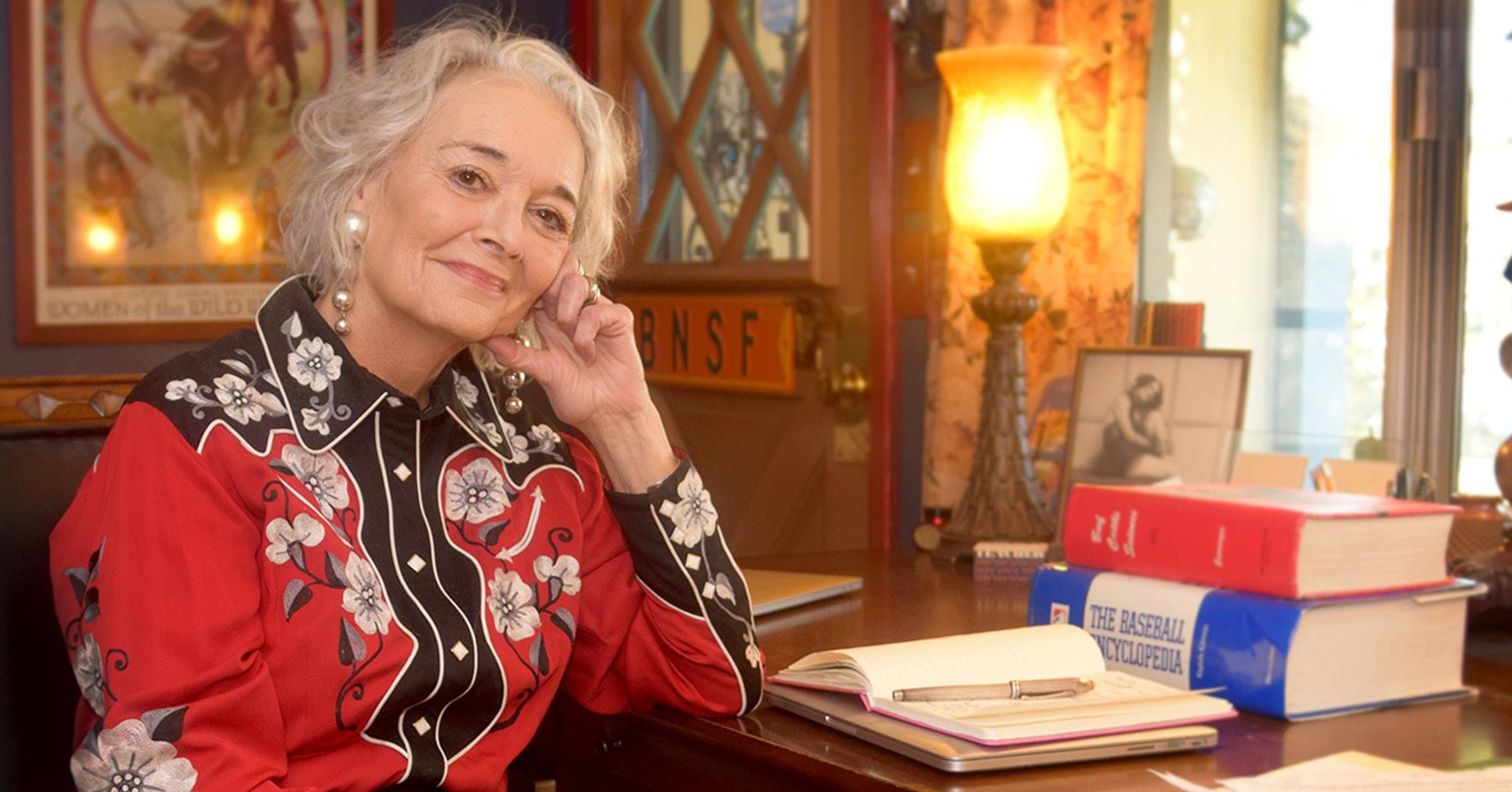
Luckily, all Nevadans are poets, Pahmeier said, even though they may not know it.
“I think the letter format helps with focusing your ideas,” she said. “What we’re asking is that people think about what it means to be a Nevadan and to tell others about that. Some (submissions) have been a single paragraph of imagery. Some rhyme, and some are metrical, but they don’t have to be traditional poems. The whole idea is to capture that authentic voice, that authentic vernacular, and to say something that matters to you.”
Some of the authors are budding bards, she said, while others have never attempted to pen a poem before and “have stepped out of their comfort zone” to try.
Some of the letters are addressed to family members or friends. Others are epistles to be sent to iconic Nevada places, people or events.
Martin A. David penned an ode to the Silver State; James Barber celebrated Reno pizza; Hunter Gowins addressed his letter to Hot August Nights; and Juno Artley wrote her sub mission from the point of view of an alien who escaped from Area 51 and is describing our state to a friend on a distant planet.
Get creative, Pahmeier said: “What would Wendover Will say to Vegas Vic? What would Highway 50 want to explain to the Vegas Strip?
What advice would Elko have for Carson City?
If Pyramid Lake could write a letter to Lake Tahoe, what would that be like?”
Metaphors are marvelous. Similes are spec tacular—but the most important thing is to be honest, she said. The poems can be serious or silly or sentimental. They may evoke sadness or laughter, longing or joy, Pahmeier said.
“Don’t worry about making a poem; don’t ag onize over it,” she said. “This is a project about story, about individual voices woven into a larg er tapestry. Just write honestly and use concrete details—observed and felt experiences.”
The poetry project’s website has some guide lines to help poets get started on their pieces. “Focus on your senses,” Pahmeier said. “If you are writing about Tonopah, tell us what you see, what it smells like, what you hear. If you set your poem in a Reno coffee shop, describe the patrons, what you see inside the shop and outside the window, what you taste. Everything is connected to your senses.”
So far, the letters submitted have ranged from verse that could make the grade for literary journals to “honest and sincere” epistles that celebrate Nevada’s people and places, she said. Some of the poems already submitted to the project can be read online.
The time period for the poems also is un limited. Maddie McCalley, for example, wrote “Letter to Past Reno”: “When Virginia Street was the main street no one had dreamed of put ting in a freeway yet / Campus was a mere five thousand students and everyone spent weekends pursuing Greek life regardless of if you had dreamt of being in a sorority or not / Ice cream cones to celebrate when the temperature finally hits 32 degrees as a high / Spaghetti in a bag on the way home from a late night in Virginia
| BY FRANK X. MULLEN
Gailmarie Pahmeier, Nevada’s poet laureate: “Don’t worry about making a poem; don’t agonize over it. This is a project about story, about individual voices woven into a larger tapestry. Just write honestly and use concrete details—observed and felt experiences.”
Photo/David Robert
City / Handcuffed to a flagpole in a nightgown in front of Carson City / Flipping through year books from the year 1969 … .”
Allyson Stronach set her time machine to a point in the more distant past in her poem, “Several billion golden years ago: This letter is to be hand canceled”: “We built fires and doctored the world with the sounds of our danc ing / We scoured the stratified earth where we overlapped, and found stones that we fashioned into shrines for the demigods of our skeletons / There were mollusks and coral and fish teeth / And stars and craters and sandstone / And we were surprised when, time after time, the pieces tumbled together, finally at rest / Flecks of rhubarb and Alaskan Fireweed Alongside guitar strings and pixels and flattened pennies / We even strapped on roller skates and took the whole tapestry for a spin / And it blinked and twirled like a great constellation … .”
“Letter to Isaac From Tom” by Tom Yearn shaw begins: “We both found something in Nevada / About a hundred and thirty years apart / You passing through, a kid afoot with a wagon train / Me an adult driving a worn out car / What did we both see in Nevada / To bring us back this way / Or did the Sacramento Valley’s bus tle/ Simply just not allow us to stay / You chose the promise of the Humboldt Sink / Nevada’s wide open spaces do have their allure / So does the green promise of water / Which drought will eventually cure / Just traveling Nevada’s back roads / Dried rivers, lakes, and streams / Foun dation, chimney, and root cellar ghosts / Pay witness to Nevada’s broken dreams … .”
Pahmeier said the project will culminate with a staged poetry reading at an arts center next summer. In the meantime, all poems are wel come. There is no wrong way to write one.
“Most importantly, have some fun with this project,” she said. “It’s intended to be liber ating, heartfelt and inclusive. Nevadans are writing to other Nevadans and specific Nevada communities, but perhaps we can speak be yond our borders and tell those outside of our state who we are and why we live and work here. Let’s get heard.”
To submit a poem, to www.nvartscouncil.org/ nevada-poetry-project to see the guidelines and instructions on how to upload your poem. Galleries of the letter-poems already submitted are available on the site.
16 | RN&R | November 2022 | RenoNR.com ARTS & CULTURE
Unglamorously gorgeous
Phyllis Shafer’s ‘The Nature of Time’ at the Lilley conjures a spell of Sierra landscapes
Each time I look at an art exhibition with the intention of writing about it, I spend a bit of time thinking about how to best frame the discussion. I’m not an encyclopedia author, so I usually narrow it down to a single angle—whichever seems most useful or illuminating.
Should I discuss how the images do or don’t respond to current trends? Try to unpack the artist’s intentions? Tell their back story? Learn the details of how this back story influenced their values, which, in turn, influenced their aesthetic decisions?
This Swiss Army Knife of frameworks usually serves me just fine. But once in a while, a body of artwork just stops me in my tracks and conjures the old phrase: “Writing about music is like dancing about architec ture.” It makes me want to stop talking, and start worrying that describing, contextual izing and explaining this particular work is going to ruin the experience of looking at it.
This is subjective, mind you. My shut-upand-don’t-ruin-it art is different from your shutup-and-don’t-ruin-it art—which leads us straight to another old phrase: “There’s no accounting for taste.” But that one’s as useless as it is ubiquitous. It’s dead wrong. It’s a giant cop-out. There is so much accounting for taste.
Phyllis Shafer’s current exhibition at UNR’s Lilley Museum, The Nature of Time, is one of those shows that makes me want to simply an nounce, “It’s perfect,” or “It’s too transcendent to ruin with words,” and walk off into the sun set. But I won’t leave you hanging. I’ll account for my taste. Here’s why Shafer’s paintings stop me in my tracks.
She paints the Sierra Nevada vistas you know about if you’re a hiker—but not the ones the tourist board might have advised. No Emerald Bay; no Sand Harbor. She paints intimate, reverent views of places like Fallen Leaf Lake, Sagehen Peak and Hope Valley, and she’s just as concerned with the minor triumphs of nature as
| BY KRIS VAGNER
with the dramatic vistas.
Shafer’s version of the landscape is always dazzling, but it’s never idealized or sanitized. In her personal taxonomy, unglamorous flowers that no one ever gets tattooed on them (like common yarrow or arrowleaf balsamroot) can take center stage—and own it. A creek lined with leafless, fallen elm trunks is still a place where you’d want to spend time. Dead conifers don’t get edited out of otherwise picturesque hillsides. And an entire composition can be anchored by that sinus-tormenting, high-desert demon (a-choo!), rabbitbrush—not just because it’s a deep, enticing gold, but because it belongs in this landscape.
Have you ever gotten really good at some thing oddly specific—then spent years honing in on the subtleties of that thing, and getting so good at it that it almost no longer makes sense? Whether it’s your sourdough or your songwrit ing, this is when the magic happens—when you take that weird, custom skill from good to amazing to, “How is that even possible?”
Shafer has a lot of these skills. She’s lived in the Lake Tahoe region since 1994 (and she was already an expert landscape painter when she arrived), which means she’s been watching the clouds roll by, the leaves turn crunchy in fall, and the snow fall and melt on the same slopes for almost 30 years.
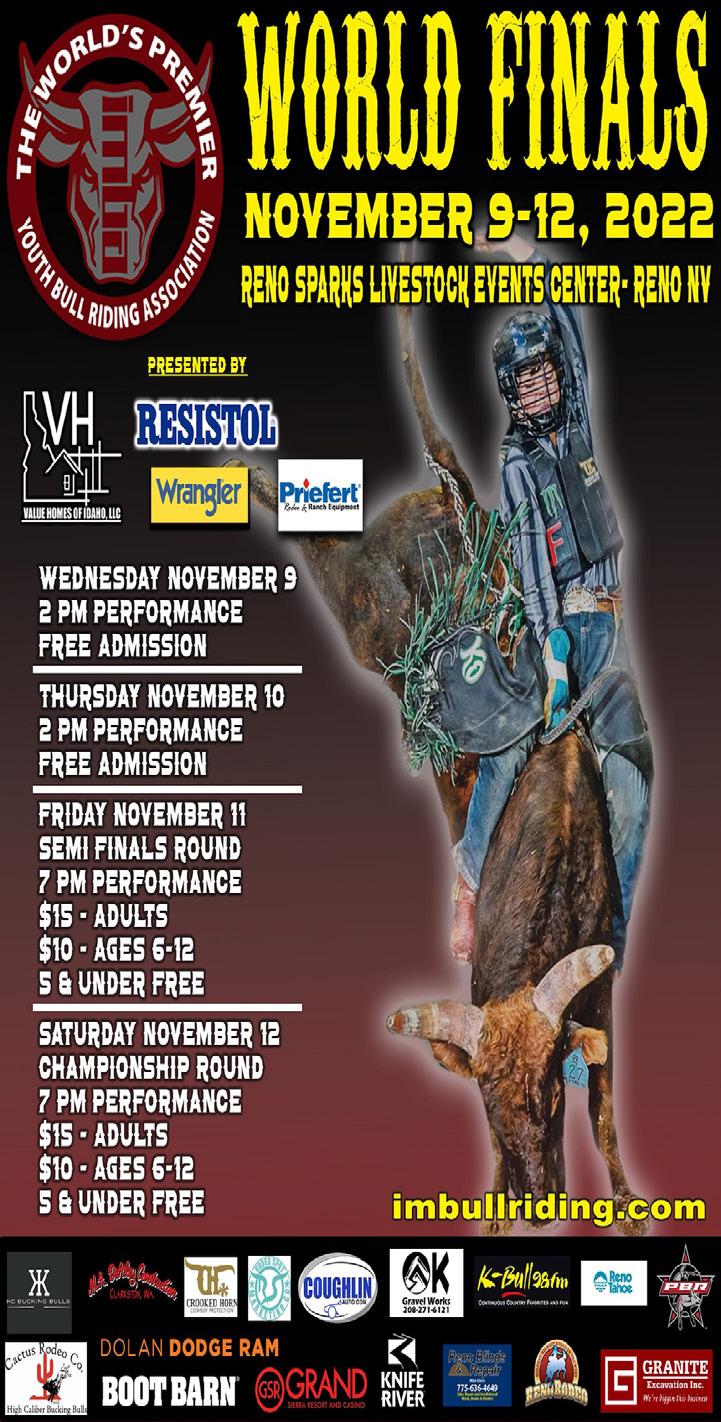
One of her custom superpowers is deciding what should look real and what should not look real. Take her clouds. She’ll distill a sky full of them into a half-dozen shades of eggshell and beige (or sherbet, periwinkle, bleached-out salmon—whatever the sky is doing that day) and lay them out in wavy bands of solid color. The clouds are several steps removed from photorealism, but it’s uncanny how much they feel like the sky above these very mountains and meadows on a sunny/overcast/winter/summer day. Shafer’s sweeps of abstraction convey the essence of these places better in one image than the hundreds of Sierra sky snapshots in my iPhone combined—even though she said it in her own, made-up language.
Sometimes, you find art that really speaks to you. Sometimes, you find art that speaks for you. Often, landscape art makes me want to leave the gallery and go hiking. This particular landscape art makes me want to stay in the gallery all day.
Phyllis Shafer’s The Nature of Time is on view at the John and Geraldine Lilley Museum of Art at the University of Nevada, Reno, through Jan. 27, 2023. For more information, visit www.unr. edu/art/museum/art.
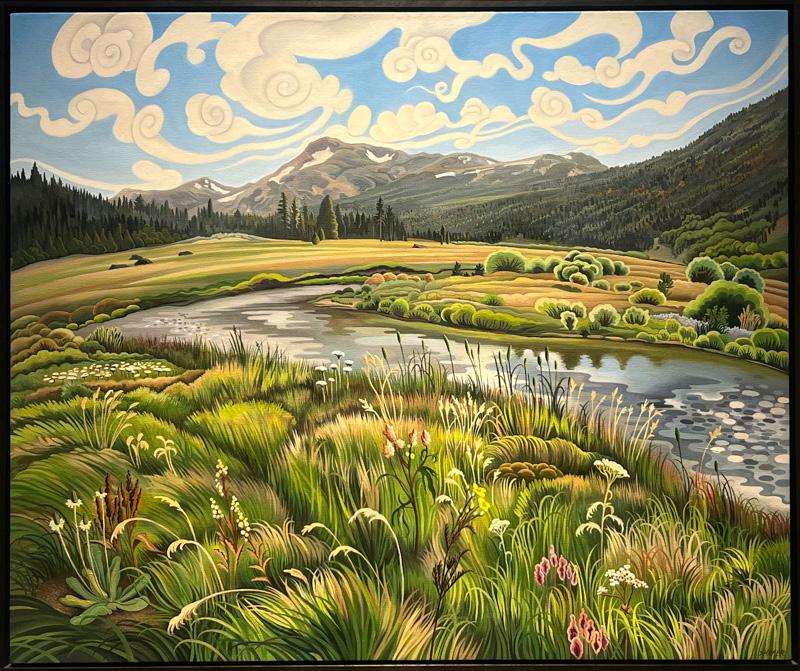
RenoNR.com | November 2022 | RN&R | 17
ART OF THE STATE
“Hope Valley Afternoon,” 2007, by Phyllis Shafer. Photo/Kris Vagner
Incomplete conclusion
‘Halloween Ends’ looks great and is well-acted, but it leaves too many unanswered questions

With Halloween Ends, director David Gordon Green’s Halloween reboot trilogy comes to a peculiar conclusion. While the film is ambitious, it’s awfully convoluted; it seems like he had too many ideas for three films. This chapter plays like a major buildup to something … but then crams a “finale” into its final minutes—leaving a lot of unanswered questions.
Overall, this is the second-best film in Green’s trilogy. It’s not as good as the stellar Halloween (2018), but it’s better than the “Evil dies tonight!” nonsense of Halloween Kills
Diehard Halloween fans may have a beef regarding how this film messes with core Michael Myers theories. Is Michael supernatural, or is he mortal? Is he a lone killer or part of some sort of weird slasher army? Is he pagan? Is he vegan? If so, does he like asparagus? If not, what is his
vegetable of choice? Does he chop his favorite vegetables with his killing knife, or does he keep the killing and cooking cutlery separate?
Does he purchase his kitchen cutlery at Bed, Bath and Beyond? If so, what’s his take on them closing so many locations? Did the Haddonfield location close, and is this perhaps driving his psychopathic fury?
I’ve always been a fan of the theory that Myers is an unstoppable, supernatural force of unexplained origin. That freaks me out. That’s not to say another explanation as to what drives his unending fury couldn’t freak me out. When it comes to “turn off your brain and watch” slasher flicks, I can be easy. The problem here is that Green and his co-writers add some intriguing new wrinkles, but those new wrinkles have no time to get stretched out. Instead, they are introduced and then quickly shut down to give the movie the final showdown between the Shape/Myers and Laurie Strode (Jamie Lee Curtis). The movie runs out of runway.
There’s been a lot of bruhaha out there about how Michael Myers is barely in the movie. I haven’t timed it, but I’m guessing Michael gets about the same amount of screen time as he received in the last two Gordon flicks. It’s not like he’s making a cameo; he shows up sparingly but effectively, like Godzilla or the shark in Jaws
Ends introduces a new character, Corey (Rohan Campbell). Corey is very similar to Arnie Cunningham (played by Keith Gordon) from John Carpenter’s Stephen King adaptation, Christine. He gets a lot of screen time and is perhaps the central character in most of the film, even more than Laurie Strode. He starts as a bit of a nerd (like Arnie), has some stuff happen, including harassment by local bullies (also like Arnie), and eventually starts leaning heavily toward evil (most certainly like Arnie). I think the ideas surrounding him are strong; had this character shown up earlier in the series, he could’ve provided a good twist for the franchise. Instead, his story and the intriguing ideas are shoehorned into the proceedings.
This seems to be another example of a film trilogy not having a firm, mapped-out plan. (Hello, Star Wars episodes 7-9!) Halloween Ends feels like it may be reversing some original ideas. It’s no secret that the pandemic halted production of the franchise; maybe it gave Green and his co-writers (including Danny McBride) too much time to think, and they wound up overstuffing the film with too many half-formed ideas.
Because the film feels so incomplete, I can’t really recommend it. I have some admiration for Halloween Ends, though. It tries hard to do something different, is acted well and looks great. It’s not a bad movie, just it’s an incomplete one.
Perhaps there is a super-mega cut out there that will fill in some of the gaps, let some of the new ideas breathe, and give the saga a cleaner completion?
Halloween Ends is playing at theaters and streaming on Peacock.
DC has scored some decent productions with The Suicide Squad (the latest film, not the first one), Peacemaker and, to a lesser extent, Joker (I still don’t like it, but everybody else seemed to) and The Batman (It was OK). But when DC goes really big, they tend to blow it—and
such is the case with their latest cinematic bedshitting, Black Adam.
Black Adam has no idea what it wants to do with its title character (Dwayne Johnson, sometimes known as The Rock when wrestling is involved). Is Black Adam a villain? Is he a hero? Is he mean? Is he nice? Does he have a big, golden heart in the end, or is he just a big moronic dickhead? Neither the script nor director Jaume Collet-Serra have any idea what to really do here; you can sense that they directed Johnson to just play it neutral.

The result is a central character with zero charisma and next to zero emotions. He’s the Terminator without James Cameron propelling him—a big dumb nothing floating around in the sky, acting like a super sourpuss and draining the film of all positive energy. This thing is dull.
And because this is a DC movie, it needs to be bombastic, CGI-heavy and convoluted to boot. Black Adam reluctantly fights the forces of evil alongside a poor man’s Justice League (called the Justice Society) involving a flying Hawkman (just like Marvel’s Falcon), a big-helmeted psychic guy (sort of a combo of Professor X and Magneto), an atom-crusher guy who grows big (like Ant-Man when he went giant in Civil War) and a woman called Cyclone who is, you guessed it, just like Storm. These characters are the ragtag team trying to give the film a fun Marvel vibe—but instead, the spastic action reminds of the worst of the Transformers movies. Black Adam fits very much into the mold of most DC comicbook movies in that it totally sucks on just about every conceivable level.
This is an extension of the Shazam universe without the fun. The post-credits scene suggests something far more interesting may be coming than anything in the movie before it. Perhaps next time they will figure out the formula, balance out the vibes and deliver something coherent?
Ha ha ha! I crack myself up sometimes! That shit ain’t happening.

18 | RN&R | November 2022 | RenoNR.com | BY BOB GRIMM
FILM
Andi Matichak and Jamie Lee Curtis in Halloween Ends.
12345 1 2
Dwayne Johnson in Black Adam.
Cooking digitally
The new R\LAB at the Renaissance Reno is part events space, part TV studio and part kitchen
The Renaissance Reno Downtown Hotel and Spa has launched a brand-new, state-ofthe-art culinary lab complete with broadcastcapable equipment to digitally capture the events that happen there.

The innovative culinary lab and specialevents venue, R\LAB, is located in the space that had been a Johnny Rockets before sitting empty for more than five years. Chef Jacob Burton’s enthusiasm for the culinary arts is the driving momentum behind the project.
“Every single day, we are in our kitchens creating—but it is then lost to the ether,” Burton said. “The dish is created, sent out, eaten and then gone. There is no real history of it, and you can’t turn it into content
that can then be educational and help the next generation of cooks.”
This lab is set up to allow the entire creative process to be shot and bundled into a professional video that will be easy to upload and share online. Not only can professional chefs capture their process and use it to market their restaurant or products; home cooks can rent the space to film the creation of their recipes to share with family and friends.
Burton said he and his team originally thought they would simply turn the space into a special-events venue; however, while they were developing things, it naturally evolved into a restaurant studio. For years, Burton has been doing online programming and training from a studio/green room he built in his office on the
Photo/David Robert
property—which wound up being his proof of concept.
His objective, with both the new space and his culinary bootcamps, is to teach people who are passionate about cooking professional techniques.

“We have created a fully immersive and interactive space to celebrate Reno’s food scene—for anyone who loves a culinary experience,” Burton said.
Burton and co. decided to keep the 1950s retro décor, which meant the team at the Renaissance had fewer modifications to make to get the space ready. These upgrades included completely removing the traditional pass window, updating appliances and cookware, installing eight high-definition cameras and five lavalier microphones, and putting in a live switching station to allow high-definition broadcasting to any platform on the internet.
“When you come in for your event, you can watch the chefs up close or through our big screens, as they explain each step of prep,
| BY CHEREE BOTELER

cooking and plating,” Burton said. “Then you get to eat what they’ve prepared, and receive a video of the entire process so you can re-create it at home.”
Burton and his team hope to use the space to promote the Reno-Tahoe culinary scene as a whole, and are looking forward to creating new events.
“We are so excited to launch this space,” says Burton. “It’s a win-win all the way around. We get to help the community throw some awesome events while capturing content that is natural marketing.”
For the last several months, the team at Renaissance Reno has been shooting videos in the space, working out the angles, finding the proper lighting and presenting to various groups. They have already done some cooking demonstrations and will do some additional test classes to get a feel for the space and work out the kinks. The team is also currently working on putting together a 2023 schedule of events.
R/LAB is available to the public for special events, from birthday and holiday parties to real and simulated cooking competitions and demonstrations. Those interested in brainstorming or booking an event at R\LAB can contact Burton at jburton@ renaissancereno.com.
RenoNR.com | November 2022 | RN&R | 19
FOOD
Chef Jacob Burton: “Every single day, we are in our kitchens creating—but it is then lost to the ether. The dish is created, sent out, eaten and then gone.”
Black Friday sale! Discounted tuition prices up to 30% off! Only available online Nov 23-28, 2022 Real Estate classes are now available in RENO Get licensed in Real Estate, Home Inspection, Mortgage, Property Management and more! New RENO location is at RSAR 5650 Riggins Ct #200, Reno KeyRealtySchool.com 800-472-3893
Wine clubbing
Memberships allow wine-lovers to try a variety of bottles, give great gifts and support local businesses
I love knowing that one day soon, my UPS or FedEx driver will exchange my signature for memories I can drink.
I belong to several different wine clubs. Wineries, of course, generally have wine clubs, but so do many retail stores, standalone wine retailers—and even television stations like Hallmark and TMC.
Many people who have a wine-club membership sign up while doing a winery tasting. There can be many advantages to joining—free tastings, discounts on wine purchases, free shipping and special
events exclusively for wine-club members, for starters. Winery wine clubs can be a great way to keep enjoying wines you know and love at a discount price.
Other wine-lovers join online clubs. Wineclub memberships can cover everything from inexpensive wines, to exclusive wines, international wines, natural wines, regional wines and even wines one can drink while watching specific movies.
For those of you who like to support local businesses, there are plenty of wine clubs for you, too. I covered three Reno-based wineries
a couple of months back—and all three of them offer wine clubs with different levels of benefits.
Engine 8 Winery offers a wine club with quarterly shipments or pickups, ranging from $85 to $229 per quarter. The basic starter club is The Caboose Club, which costs $90 per quarter; members receive four bottles of wine, as well as a 5% discount on food, retail and wines. In addition, members get two complimentary flights of three wines, invitations to wine-club events and exclusive special offers. The top level is The Conductors Club. Members get nine bottles of wine per quarter; a 15% discount on wine, food and retail; 20% discounts on bottles and cases; complimentary tours; private tastings on new releases; exclusive limited releases; and more. More information is available at www. engine8urbanwinery.com/wine-club.
Nevada Sunset Winery’s club gives members a 20% discount on all purchases at the winery; early access to new and limited releases; pickup parties with food; and the ability to taste the wines. Members must purchase the four selected bottles of wine twice a year, generally in July and November. Email alynn@ nevadasunsetwinery.com for more information.
Great Basin Winery’s club similarly includes four bottles of wine twice a year, pickup events and a discount on all wines. You can learn more by stopping by the winery or emailing info@
greatbasinwinery.com.
Reno is also home to an online wine club called Terra Vigna (www.terravigna.com)

Owned and operated by Reno resident Vijna Mathew, Terra Vigna specializes in wines produced by small family producers, or wines produced in very limited quantities. The wines are sourced from Argentina, France, Greece, Italy, Portugal and Spain; Mathew and co. have personally visited every winery whose wines they sell, many of which are biodynamic. Terra Vigna offers two clubs: Club Terra includes three red wines shipped four times a year for about $100 a shipment. Club Vigna includes three bottles that may be red or white shipped four times a year for approximately $75 per shipment. Club members also receive a 20% discount on all wine purchases, as well as 1 cent ground shipping on any purchase of six bottles or more. Wine club members are the first to be notified when large format bottles or library wines become available.
Last but not least, Reno also has a boutique wine store, Vino 100 (www.vino100reno. com), with a unique wine club. Members receive two bottles of hand-selected wines per month—members choose whether they’re all reds or whites, or one of each—as well as a complimentary glass of wine during pickup, 10% off any bottle of wine in the store, tech sheets about the wines, a recipe to pair with each wine, and club-only events, for $35 a month.
Vino 100’s owner is Karen Hyatt-Miner; she’s owned the store for more than 11 years. “My club provides wines from all over the world that include interesting and unique wine varieties that most consumers have never experienced,” she said. “When looking to expand your palate, my club allows you to do that at a great price point.”

A great price point indeed, as the value of the wines often exceeds $50.
Bob Dickerson told me why he’s been a member of the club for eight years: “Karen provides an excellent wine club that offers many specialty and limited available wines, that can help expand the wine experience of anyone who loves wine, regardless of their wine knowledge.”
Even if you are not looking to join a club yourself, memberships can make great gifts. I’ve given them as Christmas gifts, corporate gifts and thank you gifts. Not only do these memberships allow me to provide a unique and special present; I get to support a local business at the same time.
20 | RN&R | November 2022 | RenoNR.com | BY STEVE NOEL
WINE
Vino 100 owner Karen Hyatt-Miner looks over her store’s latest wine-club offerings.
Photo/David Robert
she said. “Yes, it’s a dive bar, but some things are allowed in certain dive bars that won’t be allowed here. I will not tolerate it.”
Reilly elaborated on the new ownership’s goal to do everything in their power to change the perception of the bar.
“It’s something we are particularly excited about—that feeling that everyone is welcome, and we have something for everyone here, and we are going all in on it,” he said.
One of the most ambitious changes to the space is the back patio, which features two large fire pits, shade structures, the original historic oak trees, and Dumpling Queen, a renovated airstream stationary food truck. This new food concept helps fill a hole—dim sum— in Reno’s culinary scene.
“For us, it’s about continuing the energy on the street,” Reilly said when I asked him about add ing food to the concept. “It’s ensuring the street has a place for all kinds of people in Reno.”
The new cocktail menu also features some
Stewards of vibe
A reimagined Abby’s Highway 40 opens under new ownership
Dive bars are more a feeling than a theme; it’s not something you can order online and add to a building. It feels best when the collected specter of thousands of poured drinks and long nights welcomes you into the bar like an old friend.
Many people who buy older bars do what they can to exorcise these vibes to make way for their new vision—but a se lect few appreciate the energy of a building and do what they can to breathe new life into old bones. The proprietors of The Jesse hotel and its Estella restaurant—Piper Stremmel and her husband, Chris Reilly— along with Nicky and Dash Gopinath, are the new owners of Abby’s Highway 40 on Fourth Street, and they are doing every thing they can to preserve the feeling, but give it a new groove.
When you enter Abby’s, you can’t help but feel transported to a time before smoked cocktails and cold-pressed juices. The original neon on the walls and vinyl
bar stools make you feel like you are sitting with an old friend. A select few changes were made to the inside of the bar to preserve the sentiment; they have gotten rid of the stage to make room for a dedicated pool room, giving the space a roomier feel. They also cleaned and renovated the bathrooms to provide the bar with a more comfortable feel. As we all know, most dive bar bathrooms are less than welcoming.
“We intended to keep this feeling, make little tweaks, so it is more comfortable, but it was an exciting challenge for us to try to pre serve the original space as much as possible,” Stremmel said. “There’s an opportunity to have much more fun in this space.”
“Fun” in a dive bar can be a subjective concept; historically, many dive bars are hives for misogyny, racism and homophobia, making the fun there only enjoyed by a few. But bar manager Kristin Harris-Inman has a plan to avoid this dive-bar stereotype.
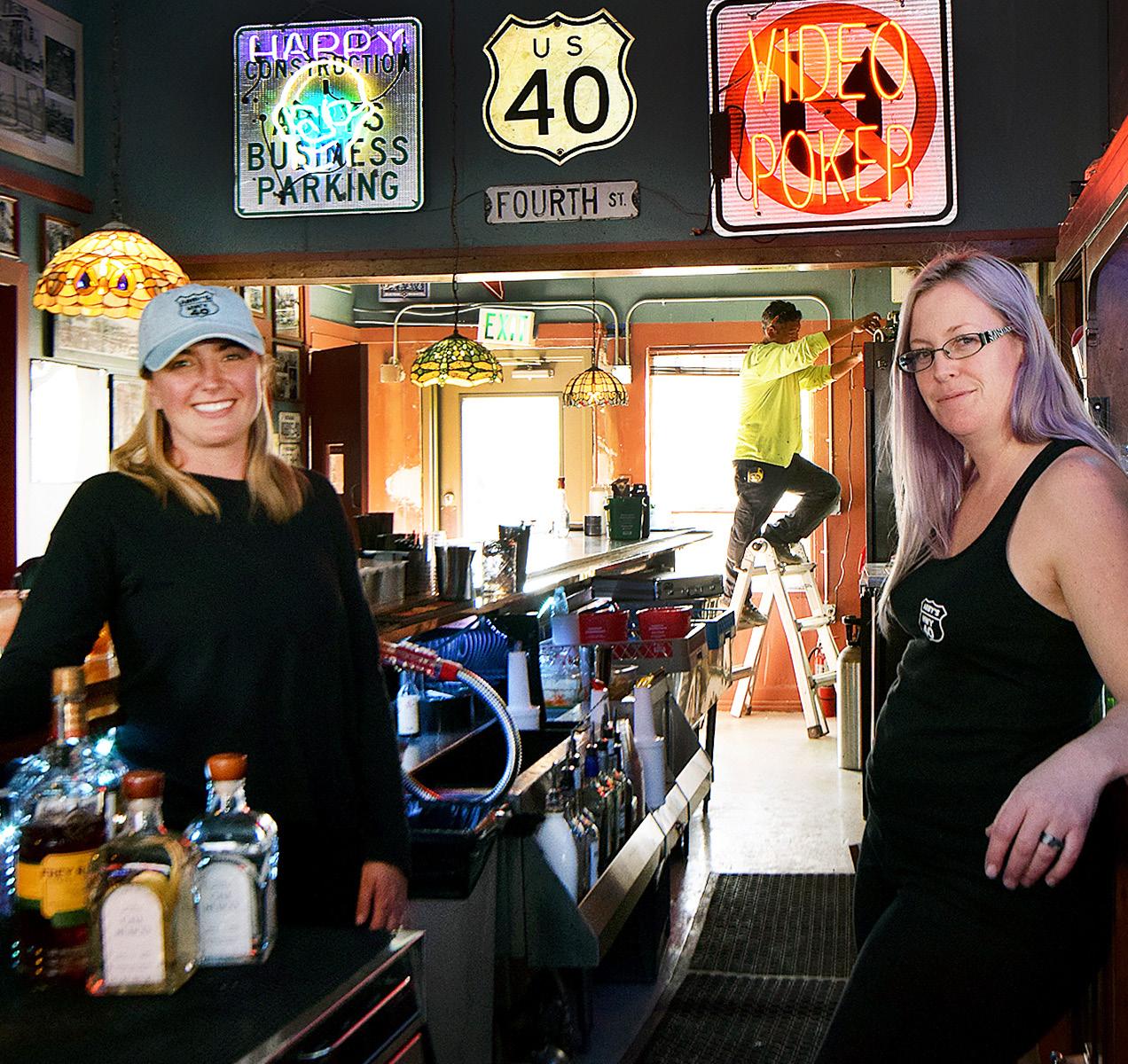
“It comes down to the training of our staff,”
 | BY MICHAEL MOBERLY
| BY MICHAEL MOBERLY
thing for everyone: callbacks to classic dive bar drinks like dirty Tuacas, turbo Coronas and otter pop shots, which will all use better ingre dients than the last time you had them at 2 a.m.
“We have a cocktail menu, but we are not taking ourselves too seriously,” Harris-Inman said. “It’s going to have that great dive-bar feel without all the dive-bar stink.”
A great bar, dive or not, is about comfort and intention. Great bar owners strive to give customers the comfort of great cocktails, a welcoming atmosphere, and the intention to treat people well and deliver thoughtful products. Few bar owners are as steadfast in bringing the folks on Fourth Street this level of intelligent joy as Stremmel and Reilly.
Stremmel put their vision in context for me: “It’s about a love of this street, and I love the work that everyone did before us that made it possible for this to happen. The buildings on this street are the best in town; they are old and beautiful and full of nothing but potential.”
I could not agree more that the new Abby’s Highway 40 is old, beautiful and full of noth ing but potential.
Abby’s Highway 40 can be found at 424 E. Fourth St. in Reno. For more information, visit www.abbyshighway40.com.
RenoNR.com | November 2022 | RN&R | 21
LIQUID CONVERSATIONS
Piper Stremmel and Kristin Harris-Inman are dedicated to making the new Abby’s Highway 40 a dive bar where everyone is welcome. Photo/David Robert
MUSICBEAT
Celebrating cultures
The Soweto Gospel Choir brings music, history and ‘Hope’ to the Pioneer Center
Music can offer a history lesson, an inspiring message or just a good time.
The Soweto Gospel Choir’s music offers all three.
The Soweto Gospel Choir is a group of South African musicians who share the joy of faith through their covers of secular and gospel music, more-modern hits and South African selections, as well as originals. Their live shows are jubilant performances, as the group works its way through an energetic set filled with both music and message. The choir has won multiple Grammys, an Emmy and worldwide recognition—something the group had in mind from the very beginning.
The group will be performing at the Pioneer Center for the Performing Arts on Sunday, Nov. 6.

“What we wanted out of the choir was to celebrate the heritage of Southern Africa— to celebrate the different cultures and faiths that we have, but also the gospel music that is sung in South Africa, and the traditional music, so the whole world will know it,” said choirmaster Shimmy Jiyane during a recent phone interview. “We wanted to
showcase that, and make people of the world hear it. That’s what drove the idea of the Soweto Gospel Choir, but it’s also to showcase the powerful entertainers and artists that are within South Africa, especially Soweto.”
The choir was formed in November 2002, and the global recognition was almost immediate.
“To be quite honest, I’m still pinching myself,” Jiyane said. “When we started, we never thought that we would be this far, and we would be this famous and this big as a choir— but something told us something. We recorded our first album called Voices From Heaven, and then in that year, which was 2003, we were No. 1 on the world music Billboard charts for three weeks. … The same year, we had an Australian tour that was for three months, and all the shows were sold out, without people even hearing what we were going to say and what we were singing. That actually gave us a picture that something is coming. Once we got to Australia, we just wowed the audiences, and then we went to Scotland, and the choir was on fire. Everybody wanted the choir, and that’s where everything started. The people of the world started listening
MATT
to us and agreeing to the music that we do, and they loved it and embraced it even until today. It’s an amazing journey.”
Two decades have brought a lot of change for the choir—and the audiences as well.
“Our music has changed a lot of people and environments,” said Jiyane. “It’s always extremely challenging to do more albums, and do more great music. It’s been a journey from where we started to where we are now.”
The Soweto Gospel Choir takes pride in exciting and energetic live shows.
“You must remember, as artists, we can only reflect what’s happening,” Jiyane said. “The awareness has to be there. We can never be clouded as artists, because we take (audiences) onstage through songs, and we spread our message. We just have to be there with our people, because when they say music is food for the soul, it is true. It is food for the soul that changes people, that gives people hope, that makes people remember that at the end of the day, the light will shine.”
Speaking of hope, the Soweto Gospel Choir’s brand-new album is titled Hope. The LP combines renditions of older South African songs like “Mbayi Mbayi” with American gems like “I’ll Take You There.” Jiyane said the goal of the album is to give people hope during these troubled times.

“It’s a great album. It’s a very emotional album. … We’ve lost sisters, family members, mothers … and people have lost jobs,” Jiyane said. “People don’t have houses; life changed. We’re giving people hope that all this will pass, and everything will go back to the norm. You can see even our leaders are failing to lead the people, and people need hope. People need to listen to something that’s going to give them hope. They need to be able to wake up in the morning and say, ‘I do have hope that one day everything will be normal.’”
Hope is something that Jiyane finds in every aspect of music, he said.
“I wake up in the morning, and I breathe and eat music; it gives me hope,” Jiyane said. “Positive music, powerful messages of music and powerful writing give me hope. Artists are the ones who actually can change the world, and music is the one to change the world.”
The Soweto Gospel Choir will perform at 7:30 p.m., Sunday, Nov. 6, at the Pioneer Center for the Performing Arts, 100 S. Virginia St., in Reno. Tickets are $28 to $78; a limited number are choose-what-you-pay tickets. For tickets or more information, call 775-686-6600, visit pioneercenter.com.
22 | RN&R | November 2022 | RenoNR.com | BY
KING
The Soweto Gospel Choir. Photo/Stephen Garnetta
-Thank you for voting for us![Your byline here.] The Reno News & Review is looking to expand its paid freelance writing team! We are looking for: • News freelancers • Feature writers • Cannabis writer • Beer columnist If you have the knowledge, the desire, and the ability to write and report, email a resume, clips/writing samples and anything else you would like to share to jimmyb@renonr.com
| BY MATT KING
Up close and personal
Carson City’s Nashville Social Club serves up intimate Americana music and ‘hip Southern’ cuisine
New music venues are always welcome, as you can never have too many good places to enjoy live music.
However, the Nashville Social Club in Carson City is more than your average music venue.
The Nashville Social Club, which opened in July, combines Southern food with intimate Americana entertainment. The venue aims to channel the vibe of Nashville’s historic venues and replicate it in Carson City. The “spirit of Music City” is spread across two stages—the Swan Music Hall and the Soft Note Stage—and the venue has recently hosted acts including Tom Rigney, and the John Doe Folk Trio.
“I have a 43-year history in live entertainment as a production manager and tour manager for some of the world’s largest legacy acts—the likes of Frampton and the Doobie Brothers and Sammy Hagar,” said John Procaccini, the owner of the Nashville Social Club, during a recent phone interview. “I always love presenting live music. My wife, Kitty McKay, who is an executive with the Carson Tahoe (Health) hospital system, is an expert in hospitality, so in combining the two passions for music and hospitality, we came up with the idea of a music venue that was a social club.
“The Nashville theme comes from our love of Nashville—and not south of Broadway, or ‘NashVegas,’ as we call it. There are about four blocks that appeal to the millennials there, and it’s Nashville as people get to experience it as tourists today. I’m not by any means demeaning that; I’m just saying that wasn’t the drive for our
theme of Nashville. Our theme for Nashville Social Club was the Southern roots, the eclectic type of food availability, the lifestyle, and the almost-melting pot, where everybody can belong.”
While many venues try to create larger-thanlife experiences, Procaccini and company are trying to celebrate the intimate concert.
“We are passionate about boutique presentations as opposed to the masses,” Procaccini said. “Also, it’s what the market will bear. We’re surrounded by large venues, with casinos and theaters who all do a pretty good job of attracting larger-scale shows and attractions and artists. We wanted to stay boutique. There are a couple of venues in Nashville, like the Bluebird (Café) and 3rd and Lindsley, which are classic, iconic music venues that are very small. Everything’s up close and personal, so that’s what we try to mimic, as opposed to large-scale stuff.”
Procaccini said he wants to introduce audiences to musicians they may not have previously known.
“The Music Discovery program is where we present Americana-style singer-songwriters from the area, local and regional, and that single/duet kind of stage runs three nights a week,” Procaccini said. “That keeps the music discovery going, and that keeps us presenting really cool attractions, the key being Americana.
Americana could be anything from an Austin/ Memphis/Nashville sound, to even old Chicago blues or even a little bit of American jazz. That keeps us, I would say, relevant in the local and regional music scene.”
The Nashville Social Club also prides itself on its food.
“It’s Southern—what we call hip Southern,
not Paula Deen Southern,” Procaccini said. “It’s not lard and butter, and you need a nap and a defibrillator after lunch. It’s hip Southern, traditional Southern dishes, mostly deriving from the Nashville area or Alabama, or somewhere in Mississippi. It’s fun; it’s light.
“For instance, fried green tomatoes: We do a couple of different dishes with fried green tomatoes. All of our dishes have gluten-free options and keto-options. … It’s almost California-esque in its presentation of the food. We do a ‘meat and three,’ which is derived out in Nashville, where you pick a protein and three sides, so it won’t weigh you down. Between that in the dining room and the music, we have been getting great results with this combination.”
The Nashville Social Club strives to have a welcoming and cordial staff, too.
“Kitty, my wife, has been very instrumental in our training programs, because her experience at the hospital for the last 14 years has been very much on the hospitality/patient-experience role,” Procaccini said. “She is just a genius at getting our staff to understand what customer service is all about. When you combine the food and the customer service, we have a really hip kind of
service team. The way they’re dressed is very casual; then they look our customers in the eye, and they speak to them. They learn their names, and our team wears backstage passes around their neck so you know their name. … Now we’re starting to weave in some special-event types of things, like whiskey tastings on Wednesday, where we pair different foods with whiskies, and our chef/mixologist talks about them.
“We’re very community-oriented. We’ve done probably three different events already in our Swan Music Hall that are supportive to different community-service organizations. The concerts are held there, and the capacity there is 225, so it’s still small and intimate.”

Procaccini said the Nashville Social Club is all about a welcoming Nashville-style vibe.
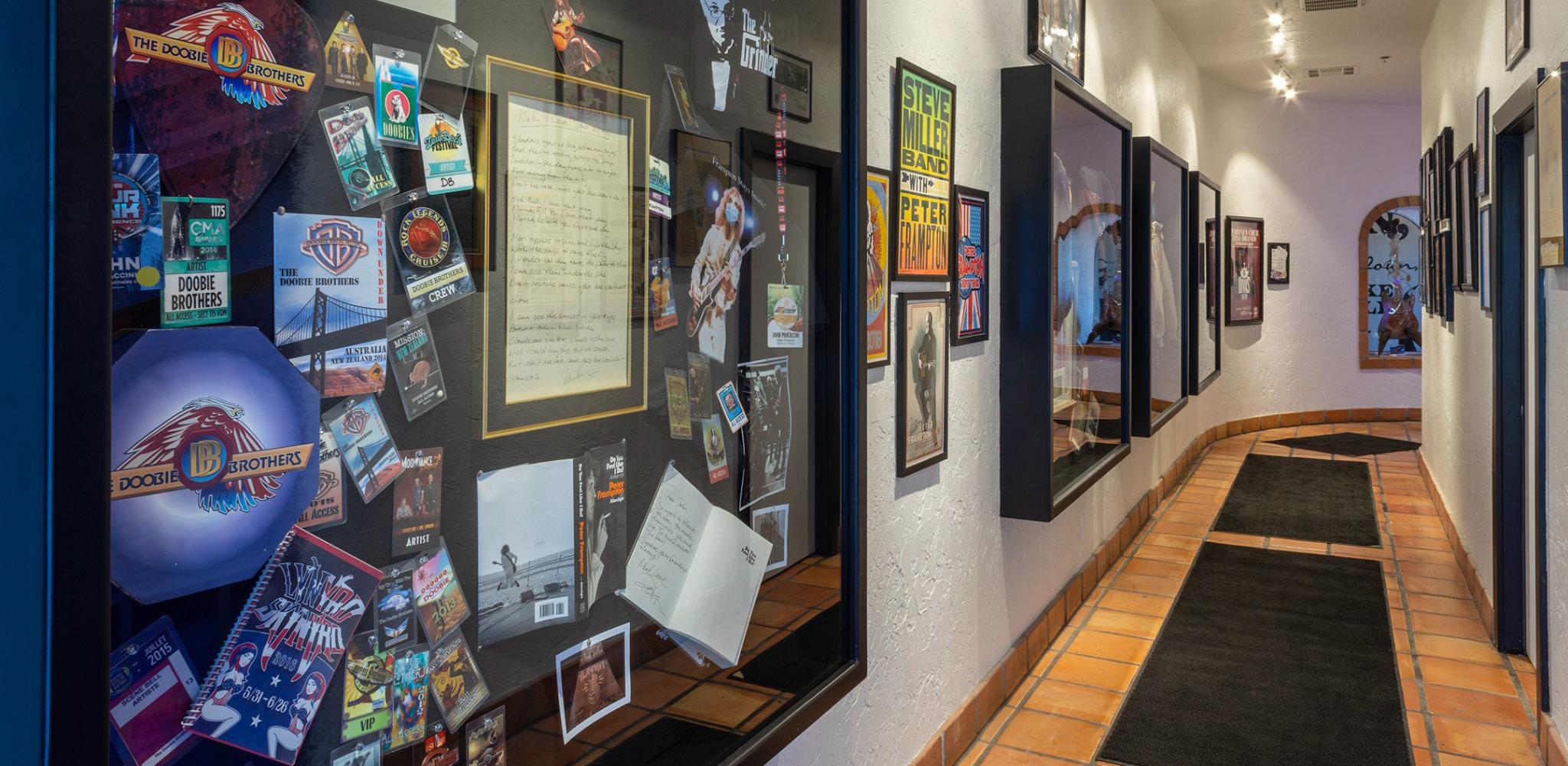
“There’s a big piece of wall art: The first thing you see when you walk in on the back wall over the kitchen is, ‘Love all, y’all,’” Procaccini said. “There are no boundaries in terms of who our customers are, who we want to feel comfortable there, and who we want to serve. There are absolutely no boundaries.”
The Nashville Social Club is located at 1105 S Carson St., in Carson City. For more information, call 775-515-0020, or visit thenashvilleclub.com.
RenoNR.com | November 2022 | RN&R | 23
MUSICBEAT
The Wander Hall at Nashville Social Club.
THE LUCKY 13
Dave Masud
Solo artist and drummer/vocalist for Vampirates
The Reno punk scene has been notable because of bands like Vampirates, which includes drummer Dave Masud providing countless blast beats and guttural vocals. Embarking on a new venture, Masud recently made a solo album, for which he played every instrument through a 12-minute, seven-song experience, encompassing pop-punk, alternative rock—and even harp sounds. For more information on Masud’s False Island, visit davemasud.bandcamp.com.
What was the first concert you attended? My first concert was Kris Kross, and my first hardcore show was Fall Silent.




What was the first album you owned? I can’t say with certainty which was my first, but some of the earliest cassettes that I remember owning were Faith No More, The Real Thing; Snap!, World Power; and Queen, Greatest Hits
What bands are you listening to right now? I have my go-tos: Jeff Rosenstock, and almost anything Mike Patton. These days, most of the new music I listen to is thanks to KWNK. I’m really digging Shintaro Sakamoto right now.
What artist, genre or musical trend does everyone love, but you don’t get? I’ve never really been able to get into EDM, but I’m sure there is something out there that would change my mind.
What musical act, current or defunct, would you most like to see perform live? I’ve been pestering Lesdystics to do a

reunion for about 20 years now.
What’s your favorite musical guilty pleasure?
I don’t believe in feeling guilt for enjoying any style of music. I do have trouble separating art from artist, which I guess would be the exception to that belief.
What’s your favorite music venue?
Favorite venue I’ve played is L’Usine in Ge neva, Switzerland. Favorite venue to see a show (now that Jub Jub’s is closed) is Great American Music Hall in San Francisco.
What’s the one song lyric you can’t get out of your head?
”You can’t turn left on Wells,” One Ton Dually.
What band or artist changed your life? How? Sucka Punch. They took me in under their wing when I was a kid, and I couldn’t be more grateful.
You have one question to ask one musician. What’s the question, and who are you asking? I’d probably ask Jeff Rosenstock how it’s possible to produce so many relatable lyrics.
What song would you like played at your funeral?
Larry and His Flask, “Ebb and Flow.”
Figurative gun to your head, what is your favorite album of all time? Refused, Shape of Punk to Come
What song should everyone listen to right now? Mr. Bungle, “Retrovertigo.”
24 | RN&R | November 2022 | RenoNR.com | BY MATT KING
Open 24-7 • Free Pool 715 S. Virginia St. www.sheastavern.com
By Matt Jones

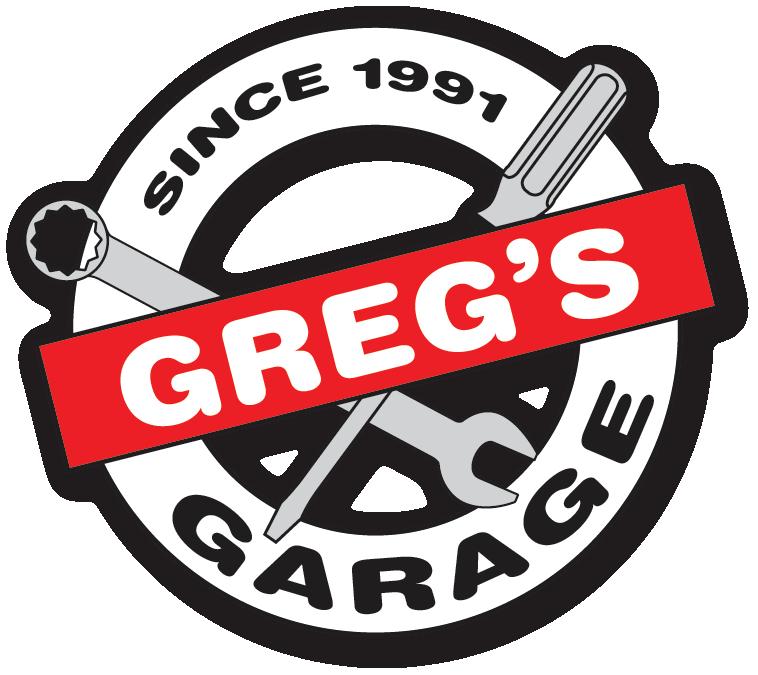

RenoNR.com | November 2022 | RN&R | 25 | BY MATT JONESJONESIN' CROSSWORD “Round and Round”— this counts double.
Across 1. New England soccer squad, for short 5. Astound 9. Messes (up) 14. Cookie that puts filling inside wafers 15. New Haven collegians 16. “Take ___ at it” 17. Sale spot 18. Ductwork opening 19. Dietary no-no for some 20. Air conditioning that doesn’t move? 23. One of the Breakfast Club archetypes 24. Abbr. for the president 25. Simple solid figure 28. “Stay (I Missed You)” singer Lisa 30. Pants pocket locale 33. Rush drummer Neil 34. “Awesome,” online 35. Verdi’s classic 38-Down 36. New York baseball player publicly displays affection? 39. Charitable gps. 40. They’re specialized for Big Macs 41. Rhythmic beat 42. Super-secret intelligence gp. 43. Antony and Cleopatra creatures 44. Talenti product 45. Get up 47. Muppet oatmeal lover 48. Ruling family full of cows? 53. Diamond center 54. Candy in a cylinder 55. Serious troubles 57. Lennox of the Eurythmics 58. Singer Levine in a recent texting scandal 59. Scheme 60. Concluding passages 61. Ex-heavyweight champ Riddick 62. “All the Young Dudes” group ___ the Hoople Down 1. Succession surname 2. Periods of distinction 3. Skateboarding version in the X Games, but not the Olympics 4. Fountain workers in the 1950s 5. Smartphone, e.g. 6. Smart one? 7. Sunscreen element 8. “___ Perpetua” (Idaho motto) 9. Fill-in-the-blanks story 10. Bolt like lightning? 11. Furry South American rodent 12. Japanese synthesizer brand since the 1960s 13. Porcine pen 21. Austrian cake 22. Kitchen sponge brand 25. Observe with secret cameras, perhaps 26. Fruit cocktail ingredients 27. Linger 28. Has a tendency 29. Has the deed to 31. “That is,” classically 32. 1990s Toyota model 34. Keurig pod 35. Late-night Cartoon Network programming 37. The Beverly Hillbillies actor 38. Antony and Cleopatra, e.g. 43. Private lines 44. What 2022 Nobel Prize winner Svante Pääbo has worked on mapping for Neanderthal Man 46. Ancient region of Turkey for which a sea is named 47. Club regulation 48. Bi-, bifurcated 49. Capture the attention of 50. Pigeon’s extinct cousin 51. List header 52. Chuck with force 53. Cheese partner 56. It peaks at 1600, for short © 2022 Matt Jones Find the answers in the “About” section of RenoNR.com! CLASSIFIED MARKETPLACE Professional Services • Rentals & Real Estate Mind, Body & Spirit • For Sale • Odds & Ends Choose between a 60-word line ad (additional words $1.50), or a 1/20 display ad, for just $99 per month! Call 775-324-4440 or email advertising@renonr.com Where else in Northern Nevada can you get your message in front of tens of thousands of people for just $99 per month? Call 775-324-4440 1 Rotate and Inspect Tires If the tread is worn down, you are going to see diminished performance, stopping distances will be longer on slippery roads, ice and snow. 2 Fix Tire Pressure Each 10 degree drop in outside temperature can mean a one-pound loss in air pressure. 3 Test the Battery Engines are more difficult to start in cold weather. 4 Change Oil Lighter weight oil is as important to starting an engine in cold weather as is a strong battery 5 Add Proper Coolant Test the protection level to prevent freezing. 6 Check Belts and Hoses Cold temps weaken these items — hoses can become brittle and fail. 7 Inspect AWD or 4WD Both systems offer improved snow traction and require maintenance. 8 Inspect Brakes The car’s brakes need to be in top operating condition. 9 Change Wiper Blades Snow, slush and salt can quickly build up on the windshield, blinding a driver if the wiper blades are worn out. 10 Top off Fluids Carry a gallon of windshield fluid so you can quickly refill the container under the hood. 410 6th Street • Reno • 775-324-0911 GregsGarageInc.com 10 Steps to Winterize Your Car Be smart and safe! $6995 SPECIAL - BOOK NOW! “FOR SERVICE YOU CAN TRUST”
Past exalted ruler
Alan Squailia
Alan Squailia is a past exalted ruler of Reno Elks Lodge 597. He’s been involved with the Elks Lodge for decades; he became exalted ruler in 1976. He recently took 15 minutes to talk to us about the Reno Elks Lodge’s events, service and scholarships, all following the Elks’ four cardinal virtues—charity, justice, brotherly love and fidelity. Learn more at www.renoelks.org.
Can you give me some history of the Elks club here in Reno?
Elks Lodge 597 was formed in Reno on June 30, 1900. The lodge was located on the corner of First and Sierra streets. It remained there until 1957, when it was destroyed in a gas explosion and fire. During the interim, meetings were held at the Mapes casino. The new lodge was built in 1961 at 597 Kumle Lane, with land donated by Reno casino mogul Raymond “Pappy” Smith. In 1961, Reno ended at Plumb Lane, so Kumle Lane was way out there. Some of the old-timer Elks didn’t think that anyone would travel that far; they didn’t want it out there. But here we are today.
The Elks club began as a men’s club. What has changed over the years?
When I started, it was strictly only white American men who were allowed to join—no Blacks, no Asians. It was very strict, and for many, many years, that was the way it was. Over the years, all of that has changed by allowing ethnic groups in, and the biggest change was allowing women to join in 1995. The women bring a touch that has never been a part of a men’s-only organization.
How many women are officers in the Reno lodge?
There are more women officers than male officers here. Of the main group of seven officers, five are women. Laura Henry became the first Reno exalted ruler in April of this year, voted in by the lodge.
The Elks have been viewed as an older persons’ club. Has that changed over the years ?
There are a lot of younger people joining. The majority of new initiates are people ages 30 to 40. They want to support the community and give back. It’s a safe place for families to come and socialize, and we have a big, wonderful pool area to enjoy. It’s one of the largest private pools in the area.
What are some of the charities that you support?
We support so many; it’s unbelievable. We do scholarships for various schools. We have a huge nursing scholarship. We do a couple hundred food baskets at Christmas time that are put together at the lodge and hand-delivered to needy people.
Juvenile services—we help with residential foster care that helps individuals who are aging out of foster care with important life skills; that’s ages 15 to 18. We try to help keep sibling bonds with children who are separated in foster care with activities and events to enhance their relationships, as they are separated from their brothers and sisters. We help with the homeless, and have a program that assists single parents with children. The Elks club also helps out veterans; we have a group that goes to visit veterans in the hospital and delivers books to them. They will not be forgotten, and we will take care of them.
What events do you have coming up?
We have our biggest event of the year coming up in early November. It’s the 110th Uncle Dan’s Charity Dinner. “Uncle Dan” Wheeler owned a ranch where the downtown post office building is today. He also owned a lot of other properties in the Truckee Meadows, and he raised turkeys on his ranch. At Thanksgiving time starting in 1909, he would give free turkeys to the homeless people and people in need. He was an Elk, of course, and that became a yearly practice, and we still do it today. The dinner is our biggest fundraiser of the year. It’s our primary fundraising tool. We use those funds to support our programs for the entire year. The 110th Uncle Dan’s Charity Dinner will be held at the Reno Elks Lodge on Saturday, Nov. 5, with cocktails at 5 p.m., and dinner at 6 p.m.; $10 admission.

26 | RN&R | November 2022 | RenoNR.com | BY DAVID ROBERT15 MINUTES

RenoNR.com | November 2022 | RN&R | 27




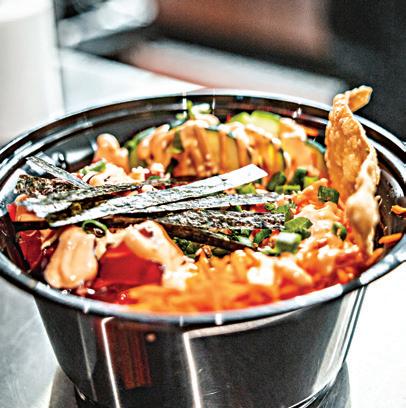

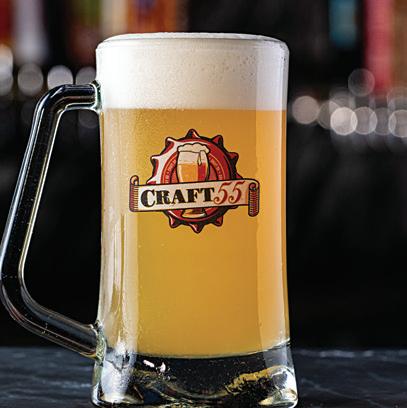
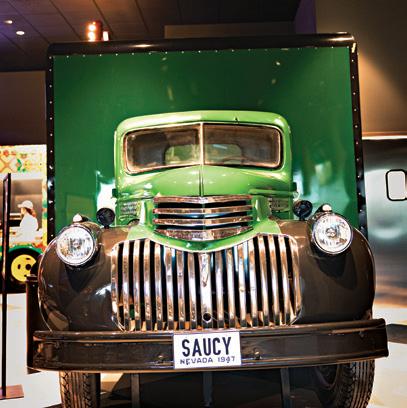


28 | RN&R | November 2022 | RenoNR.com LEGENDSBAYCASINO.COM LOCATED IN SPARKS AT THE OUTLETS AT LEGENDS Free item of equal or lesser value than purchased item. Free pint limited to 3 per person per day. May not be combined with any other offer. Restrictions apply. Management reserves all rights. NOVEMBER 1ST-30TH ANY ENTRÉE. ANY TRUCK. EVERY DAY! WASH IT DOWN WITH A FREE PINT (WHEN YOU BUY A PINT) AT CRAFT 55. BUY ONE, GET A 2ND FREE. ANOTHER BONUS? CATCH LIVE ENTERTAINMENT from artists at The Bandwagon. These jam sessions happen on a classic chassis – a 1953 White Motor Company 3000. LOCATED INSIDE THE FOOD TRUCK HALL VIEW OUR WEEKLY LIVE ENTERTAINMENT SCHEDULE! BECAUSE THIS IS HOW WE ROLL!






 BY DAVID ROBERT
BY DAVID ROBERT




























 Photo/Maggie Nichols
Photo/Maggie Nichols





















 | BY MICHAEL MOBERLY
| BY MICHAEL MOBERLY























